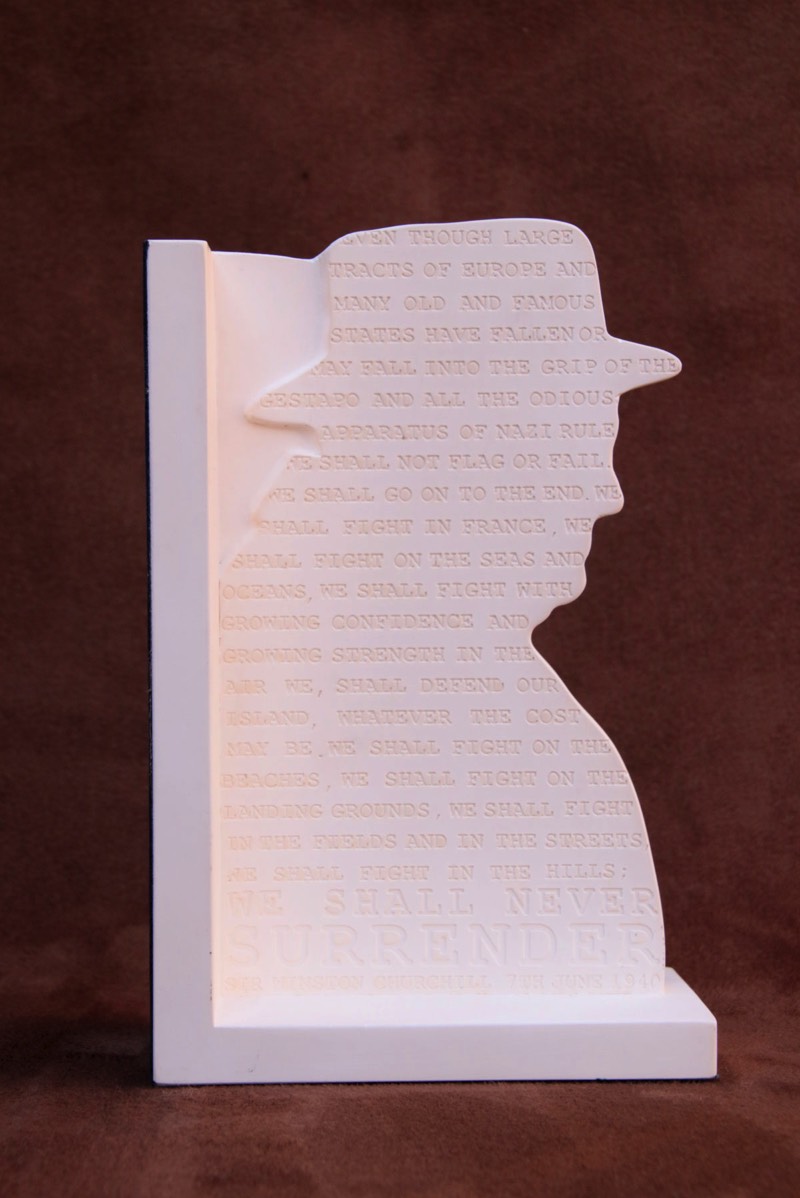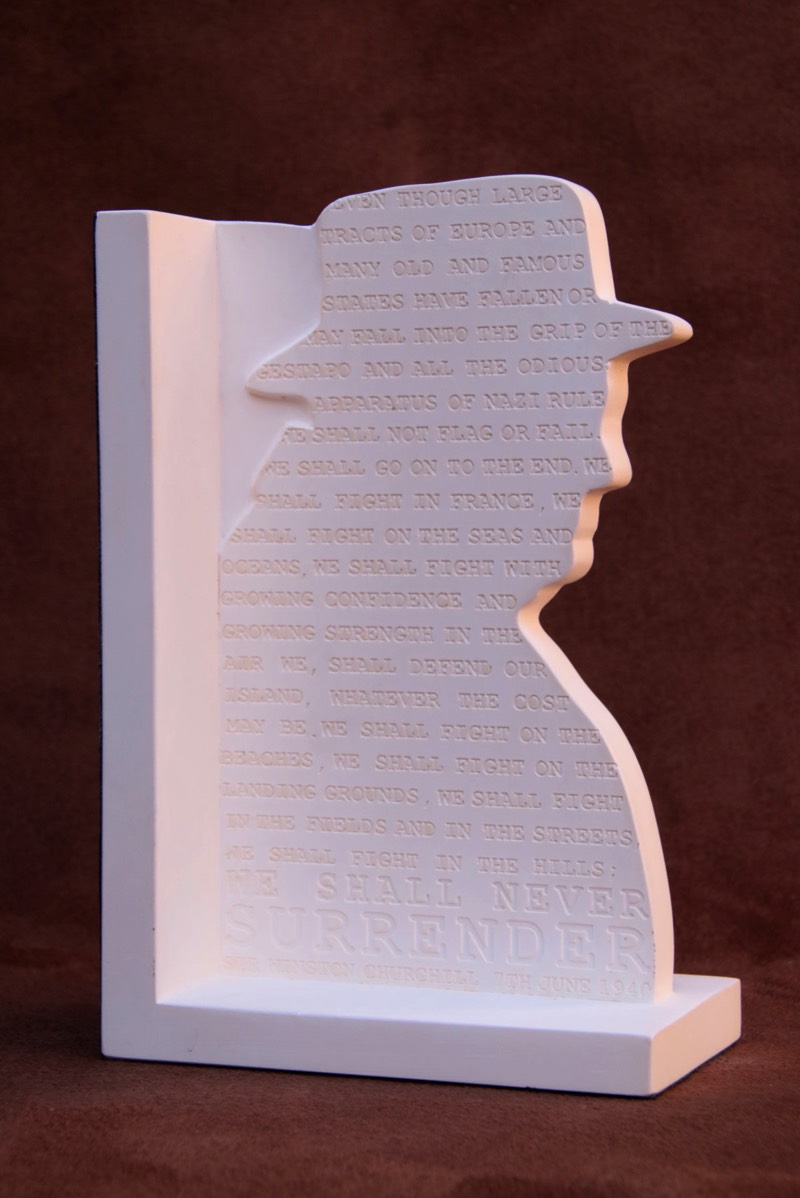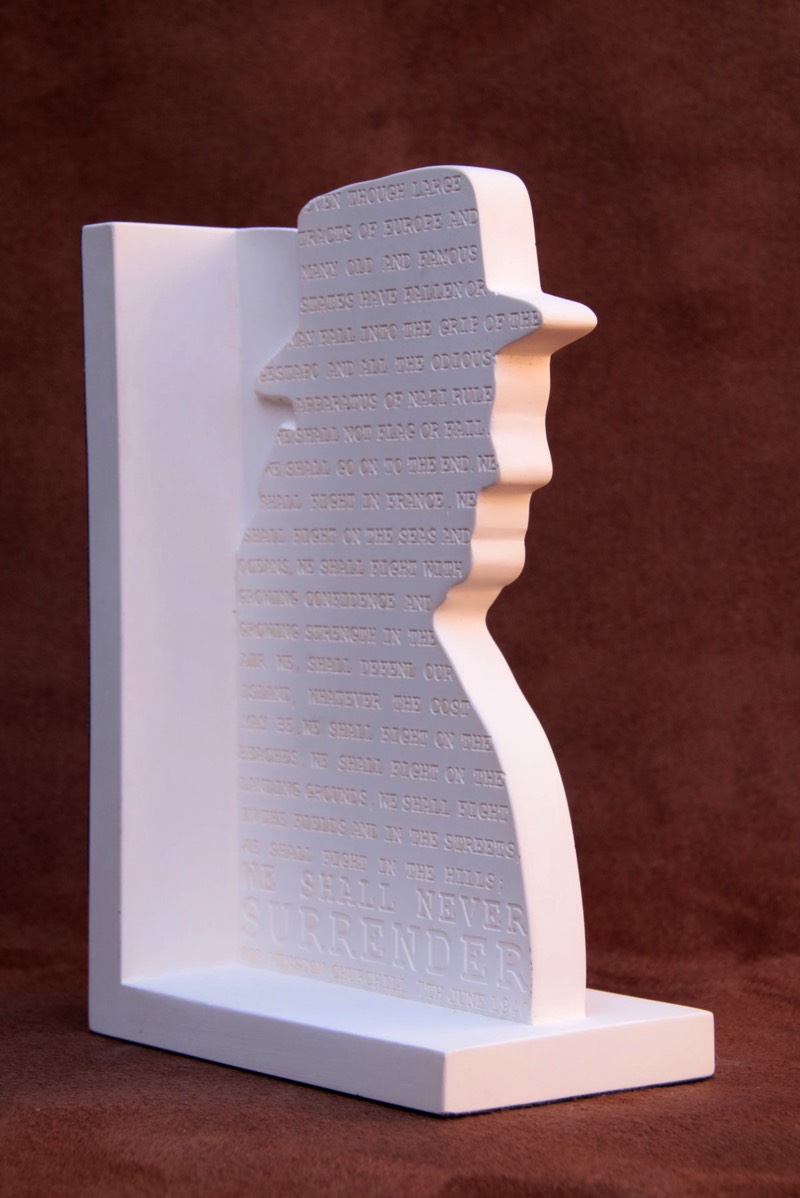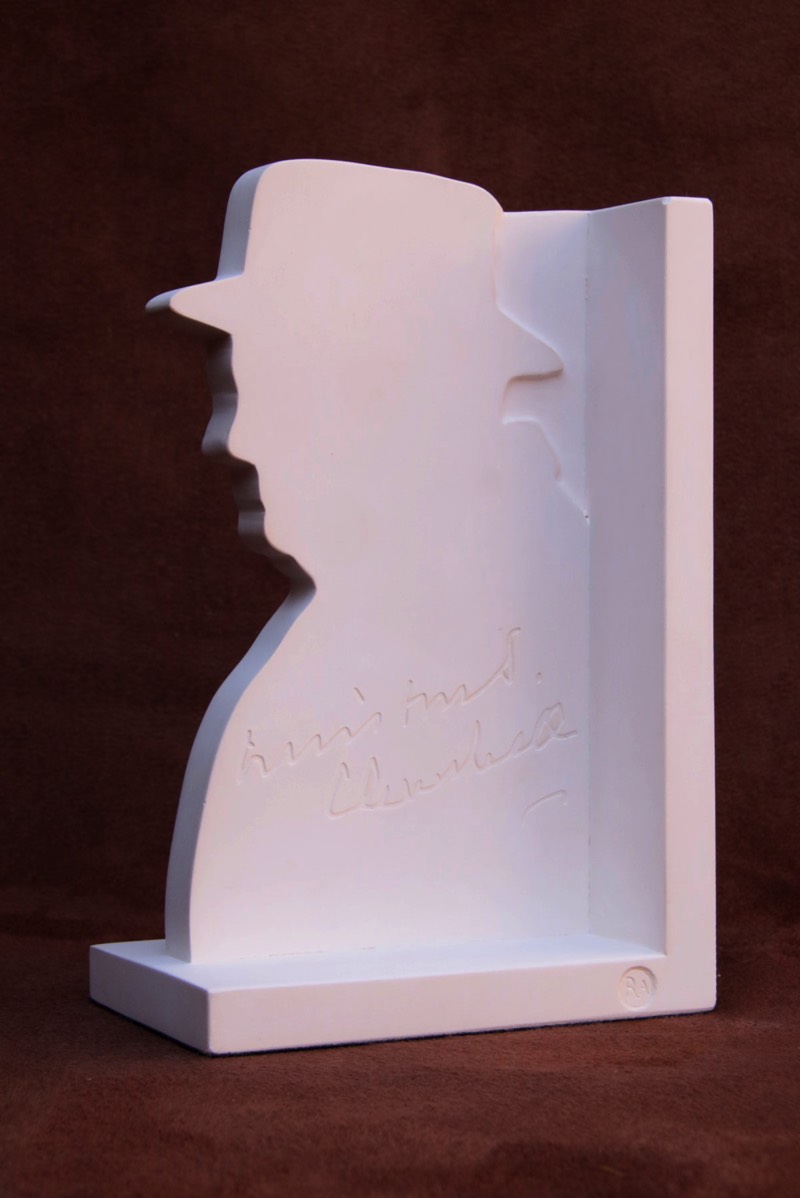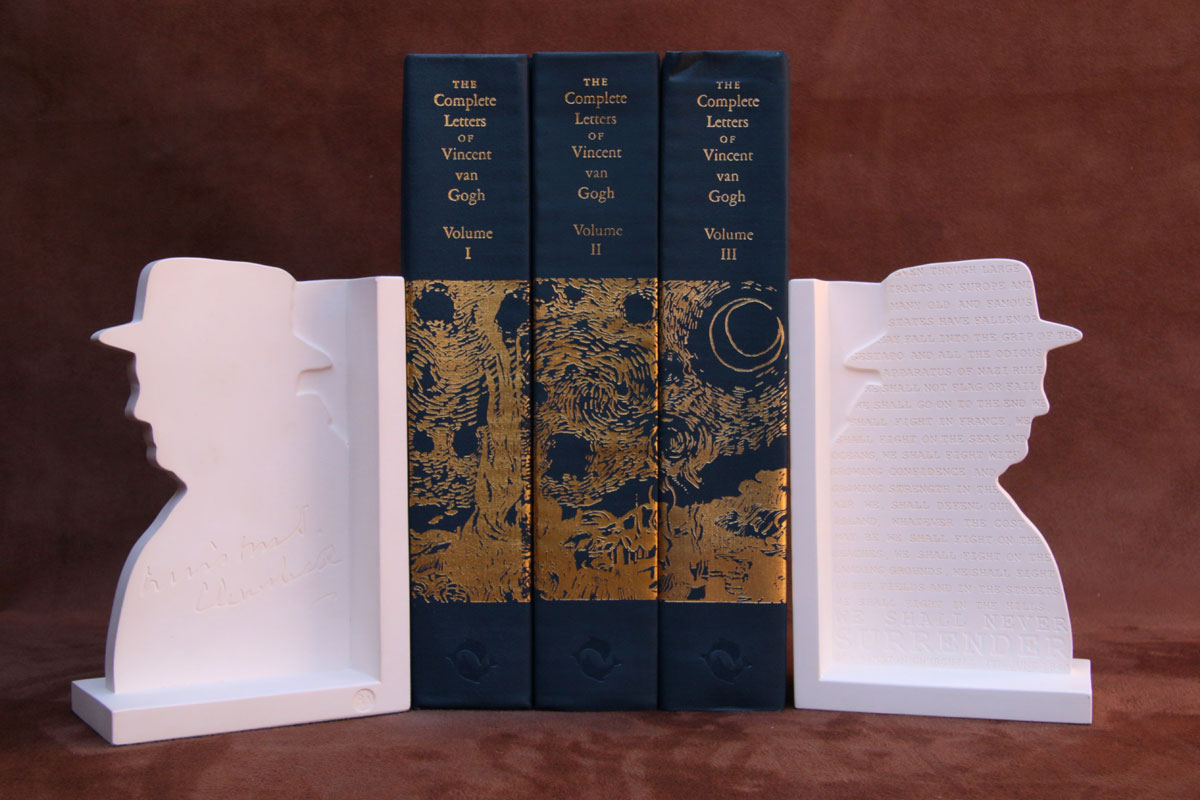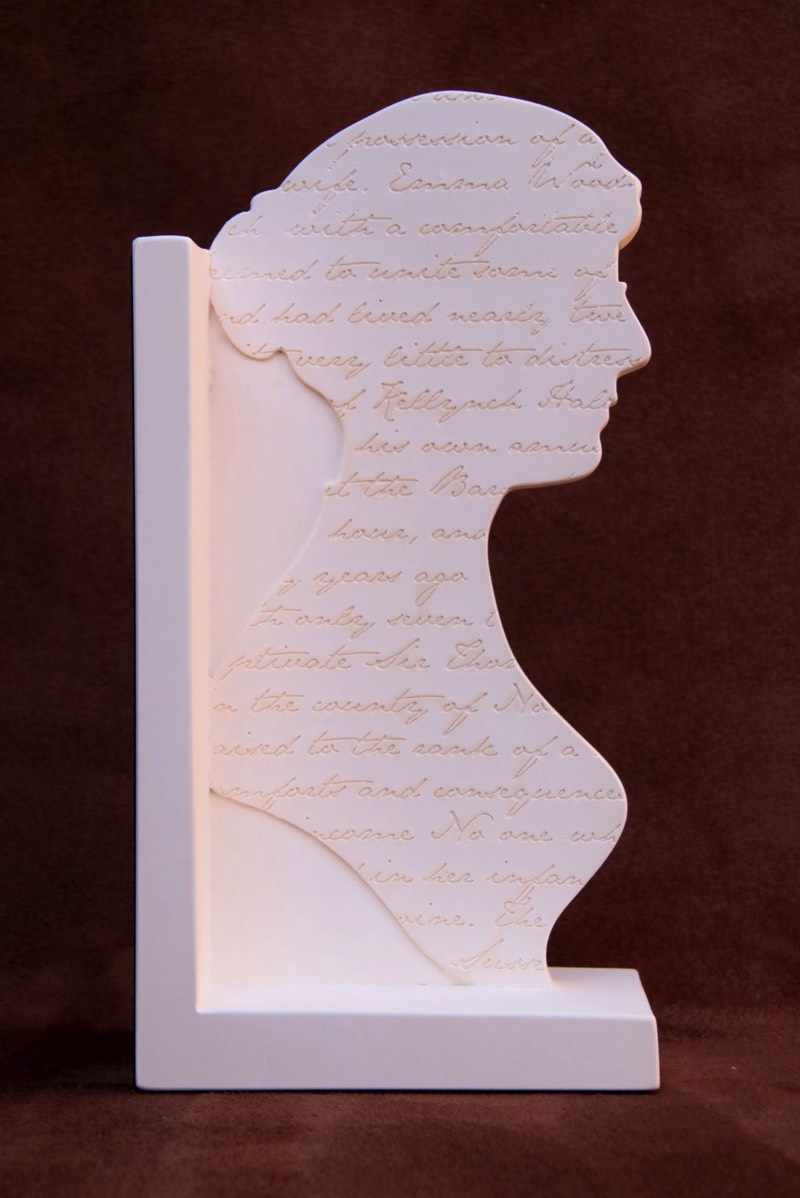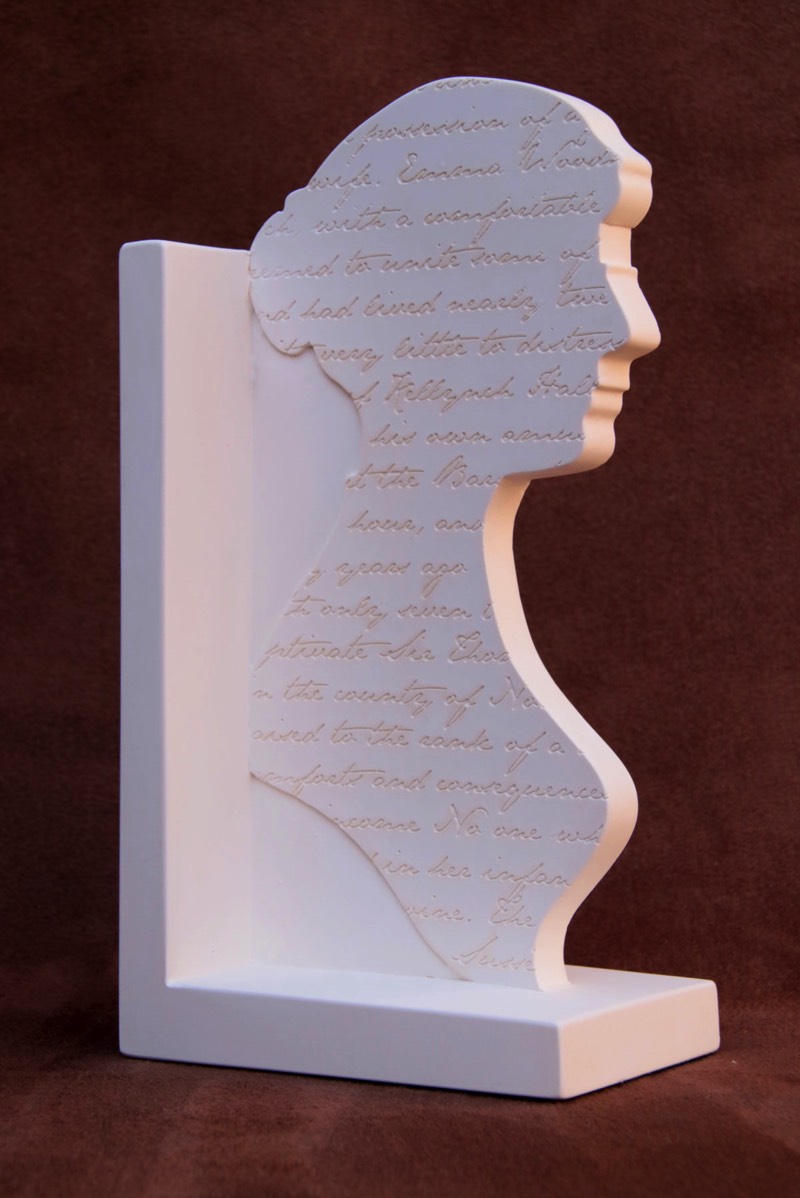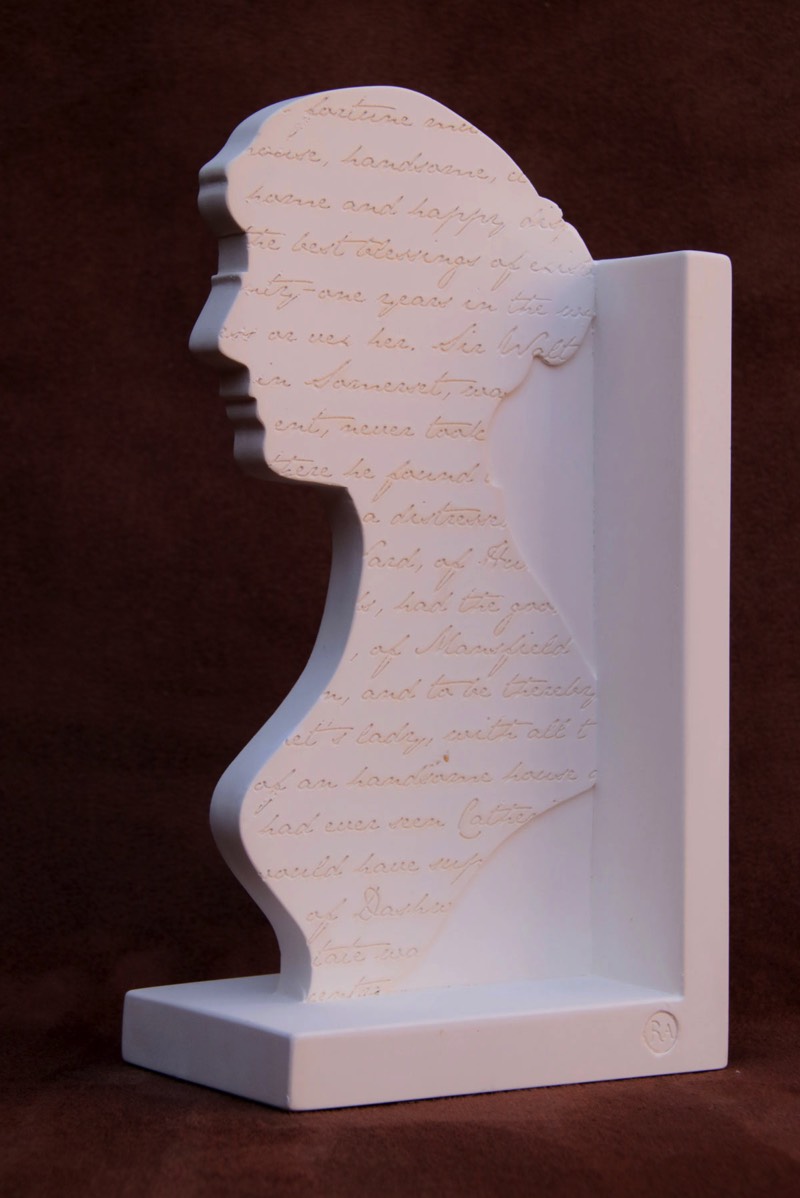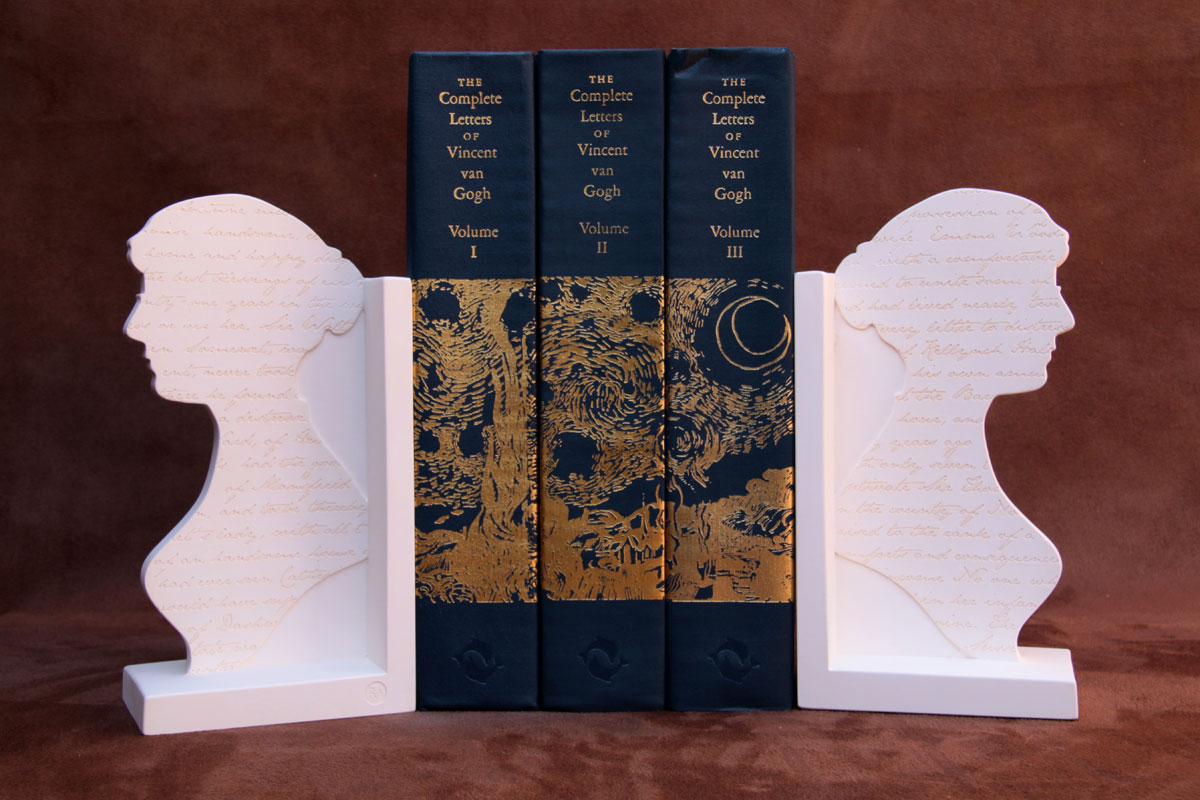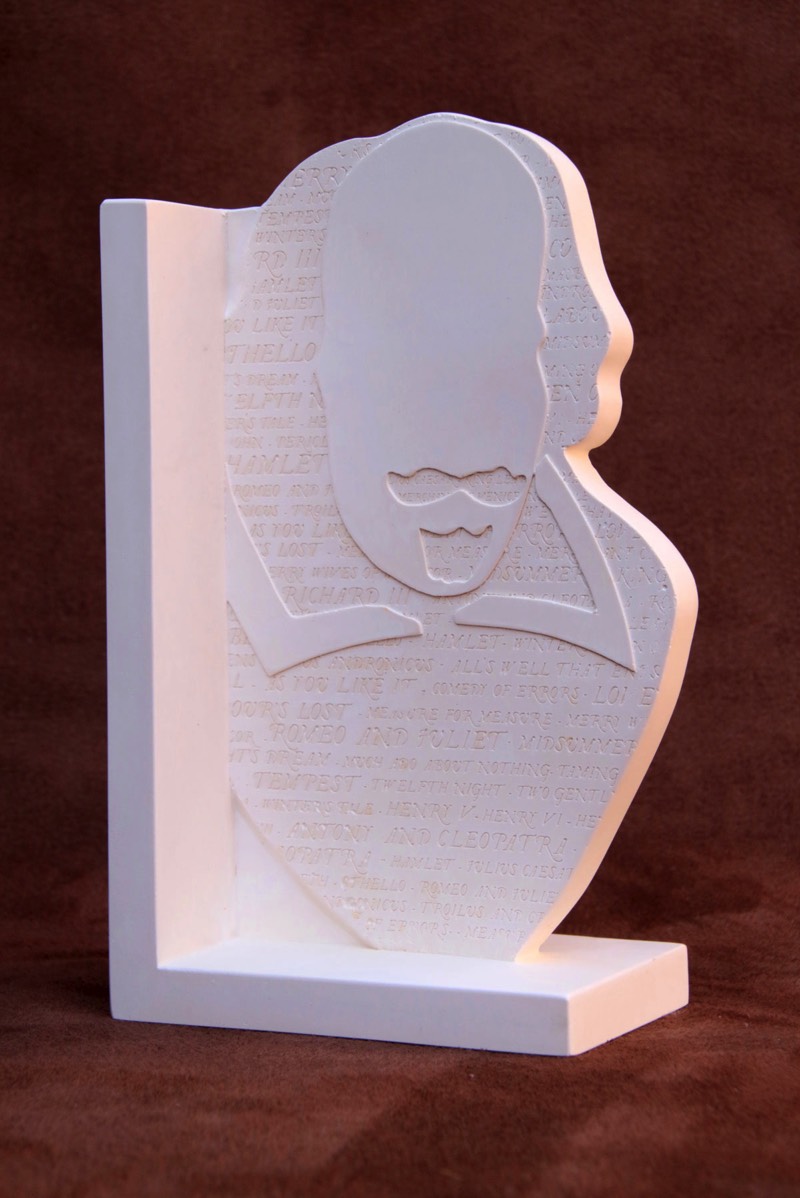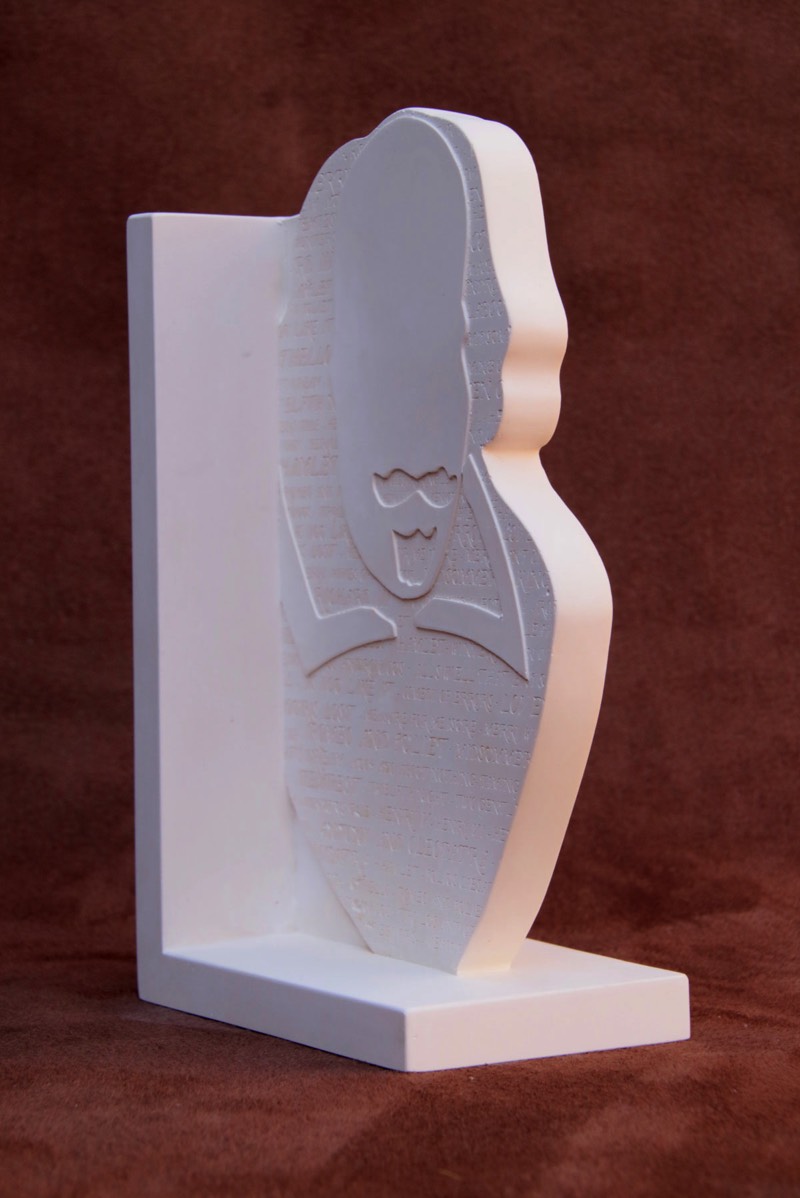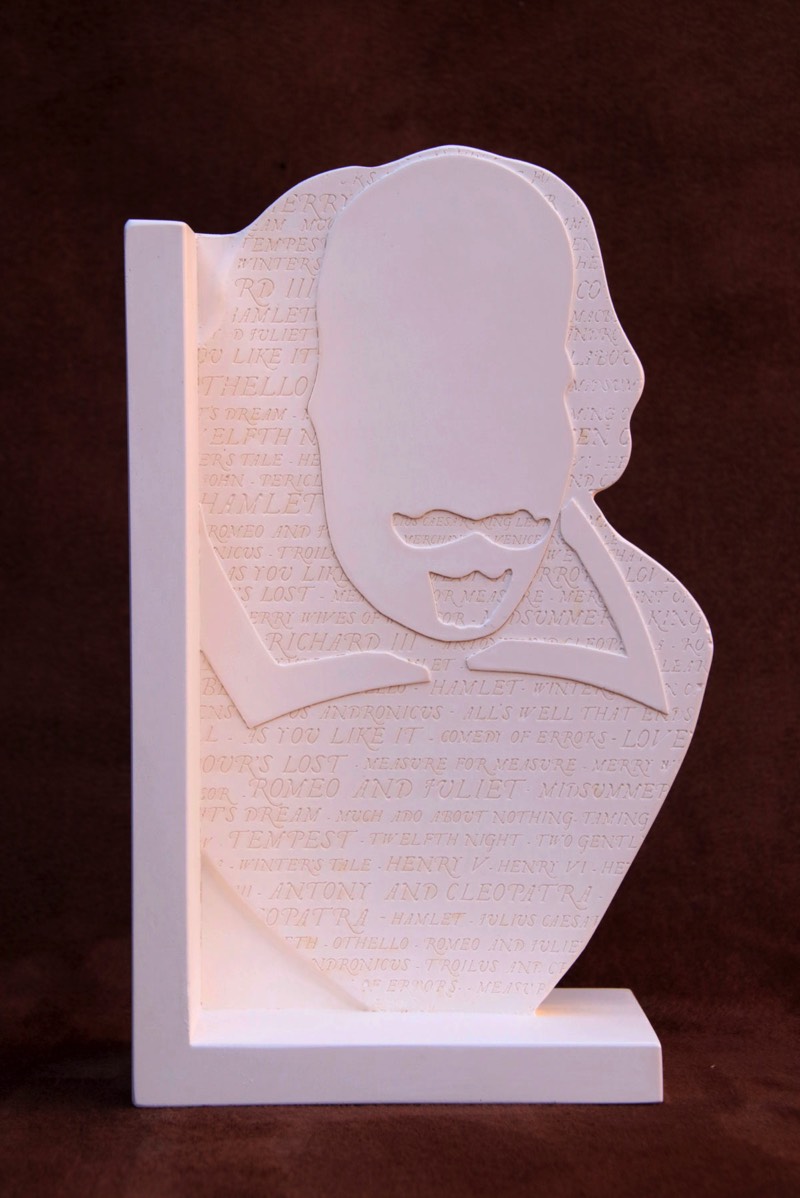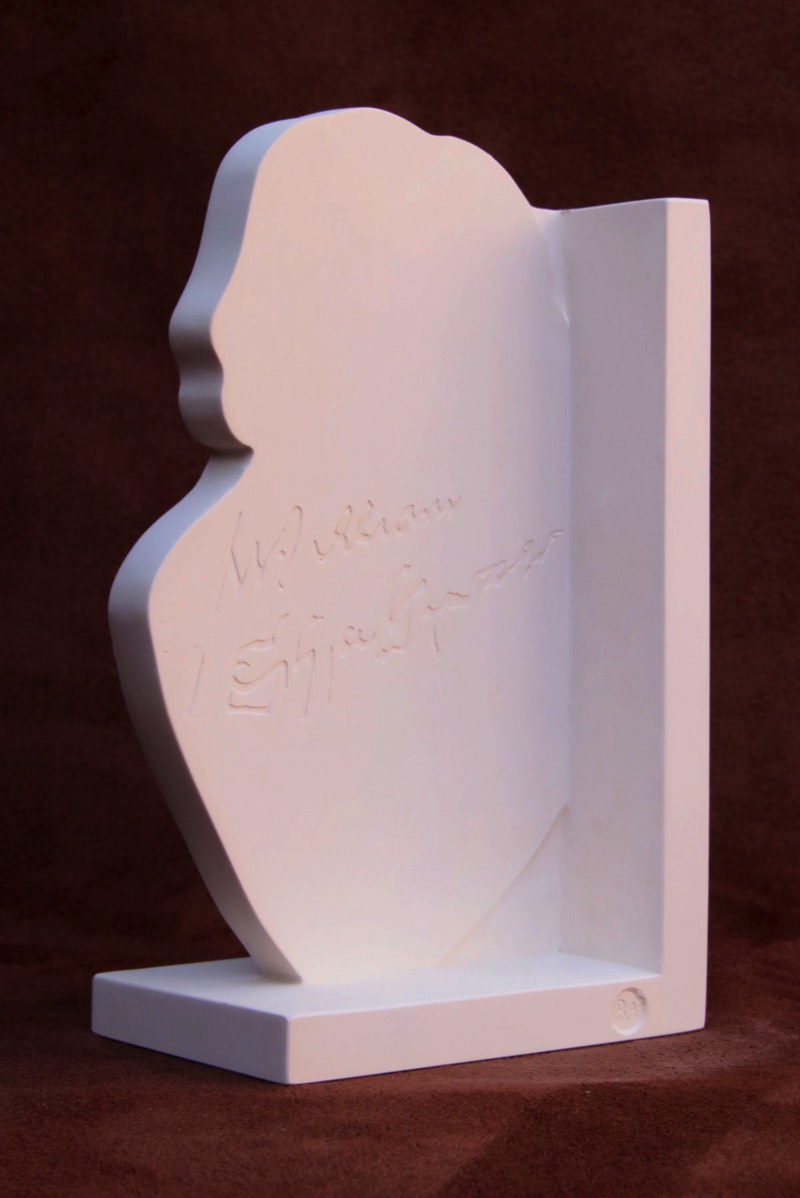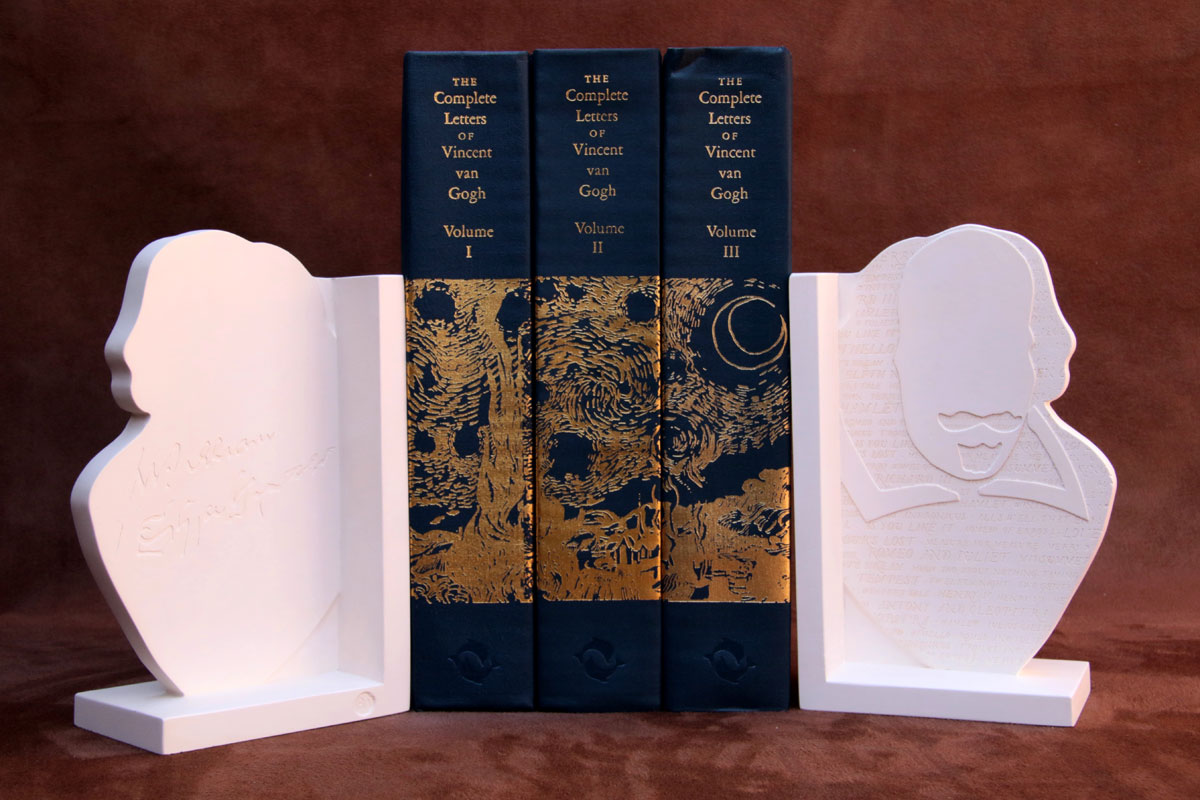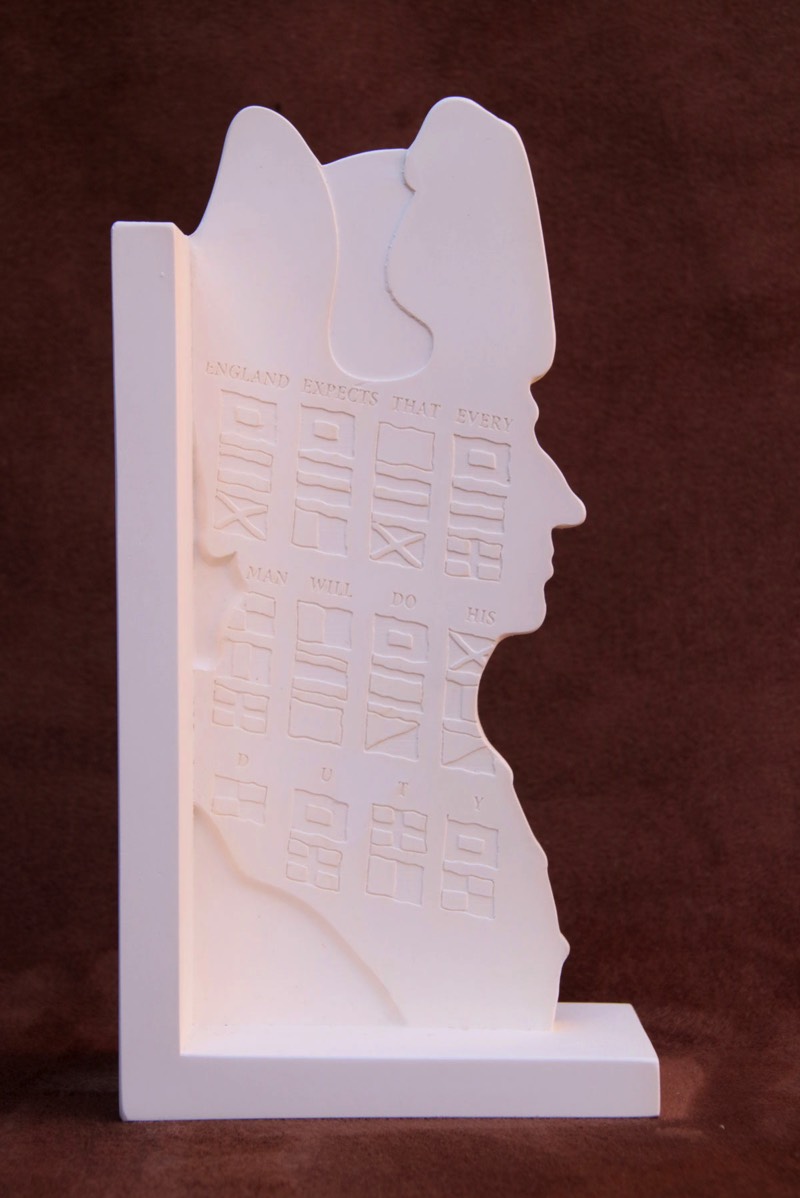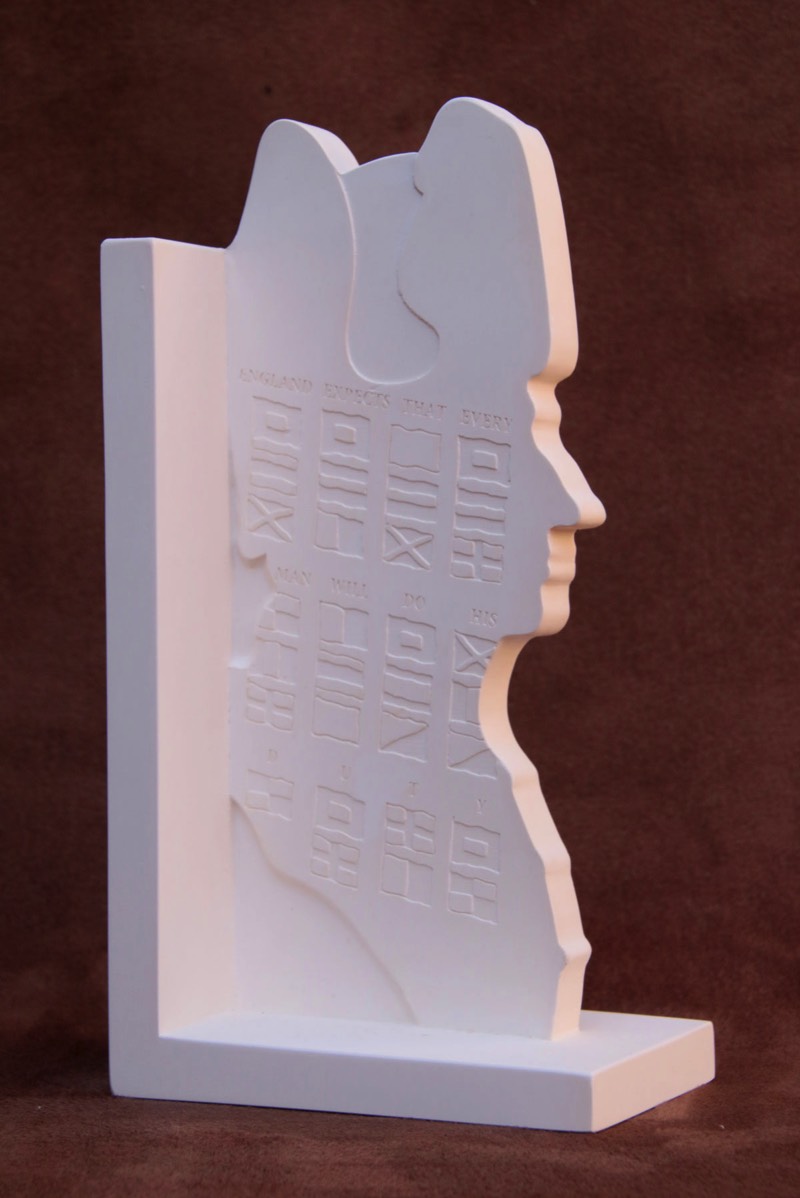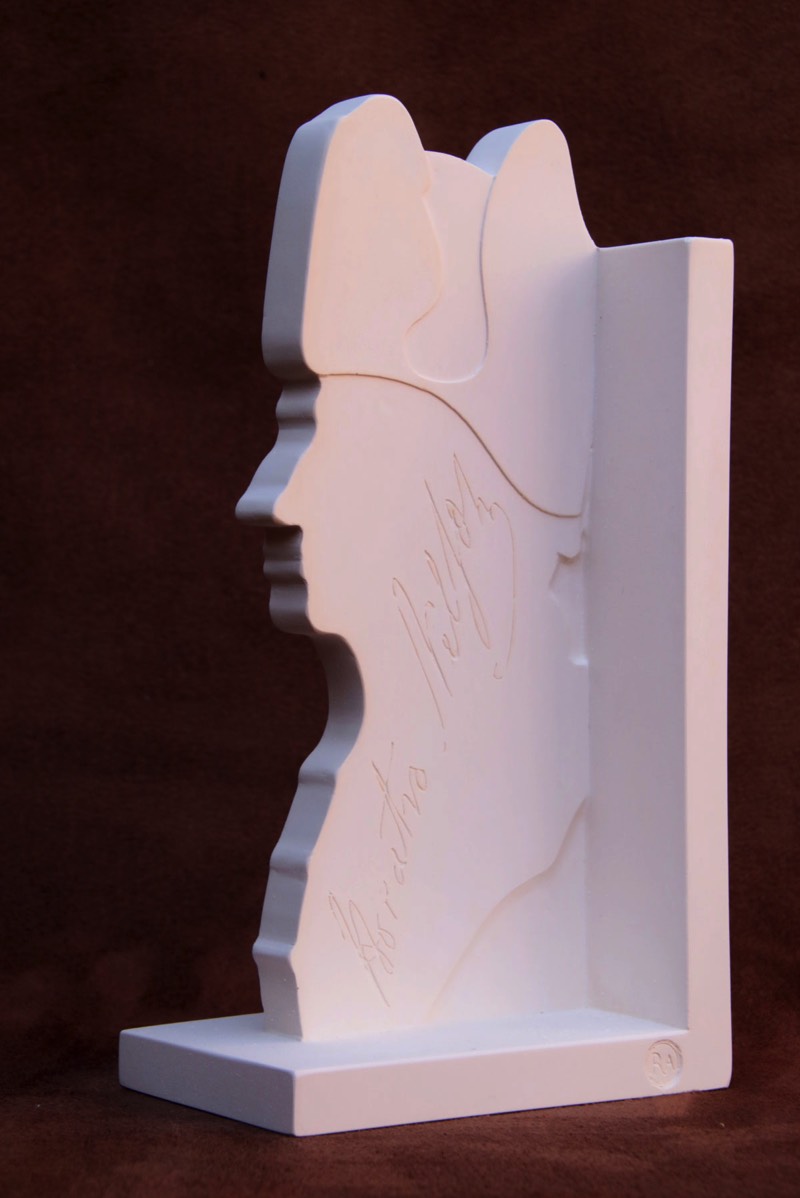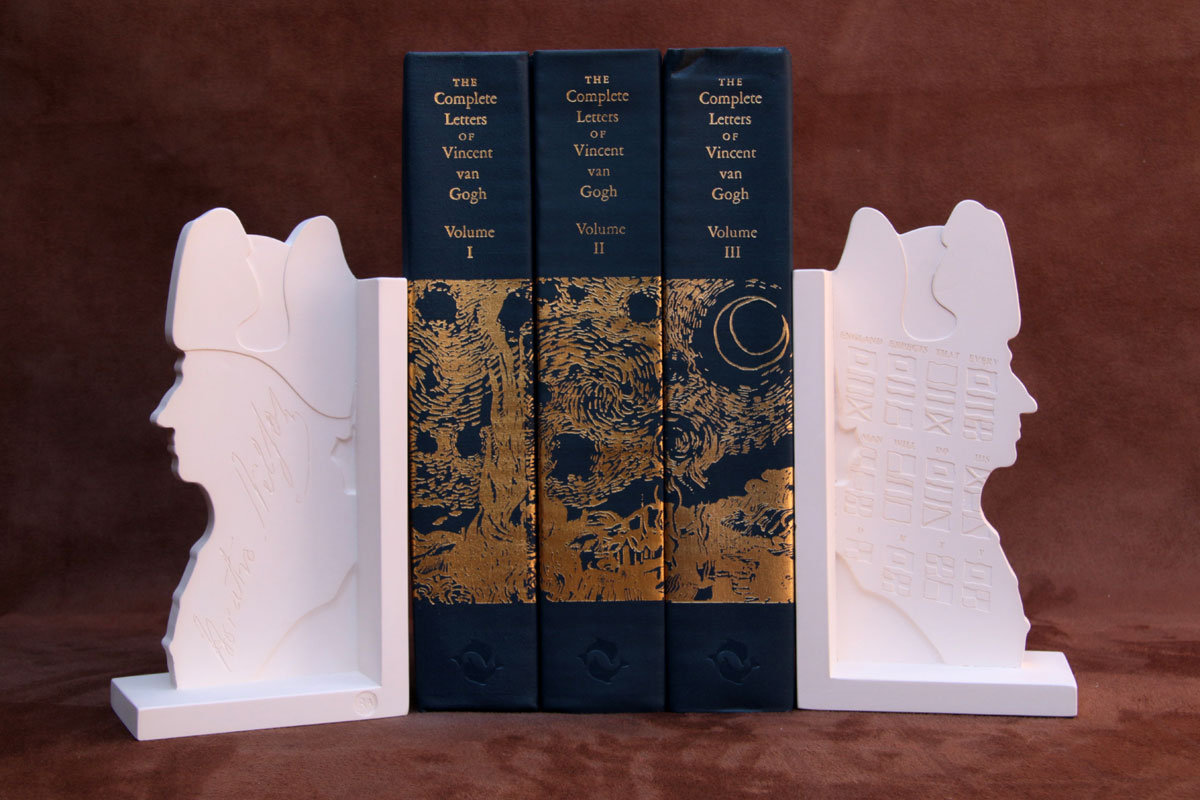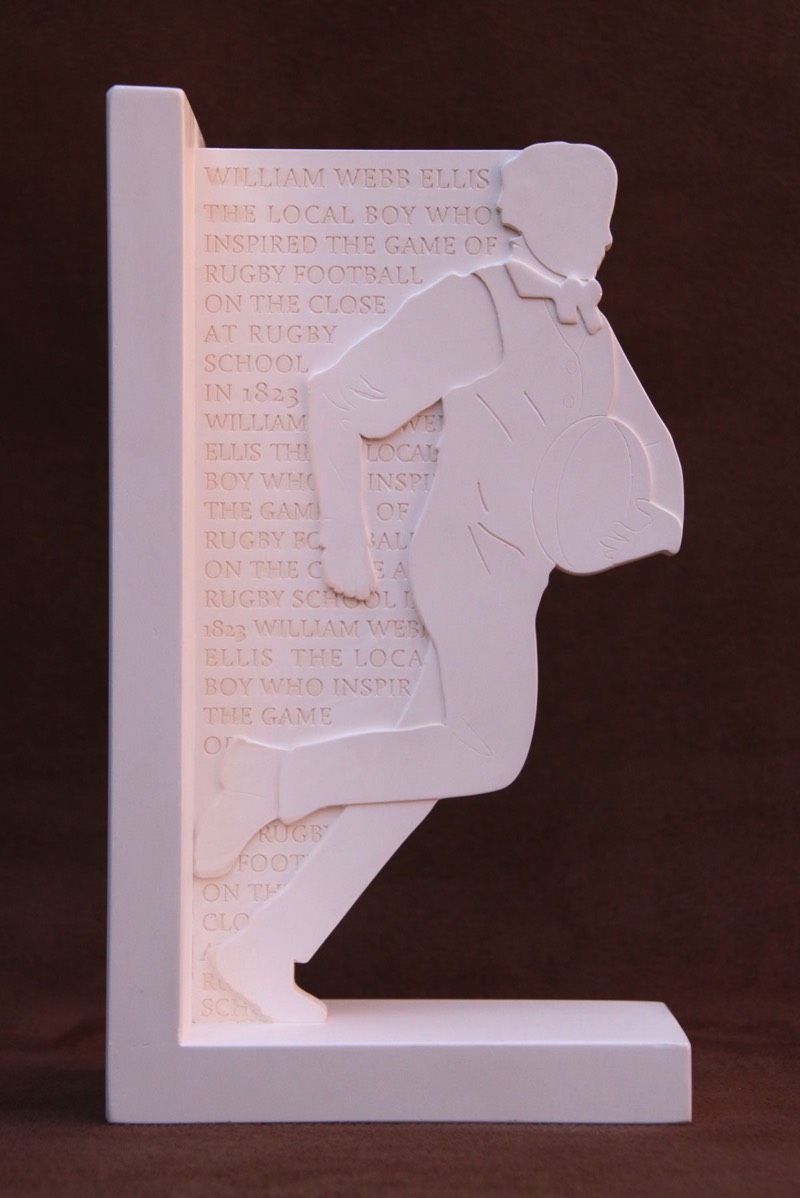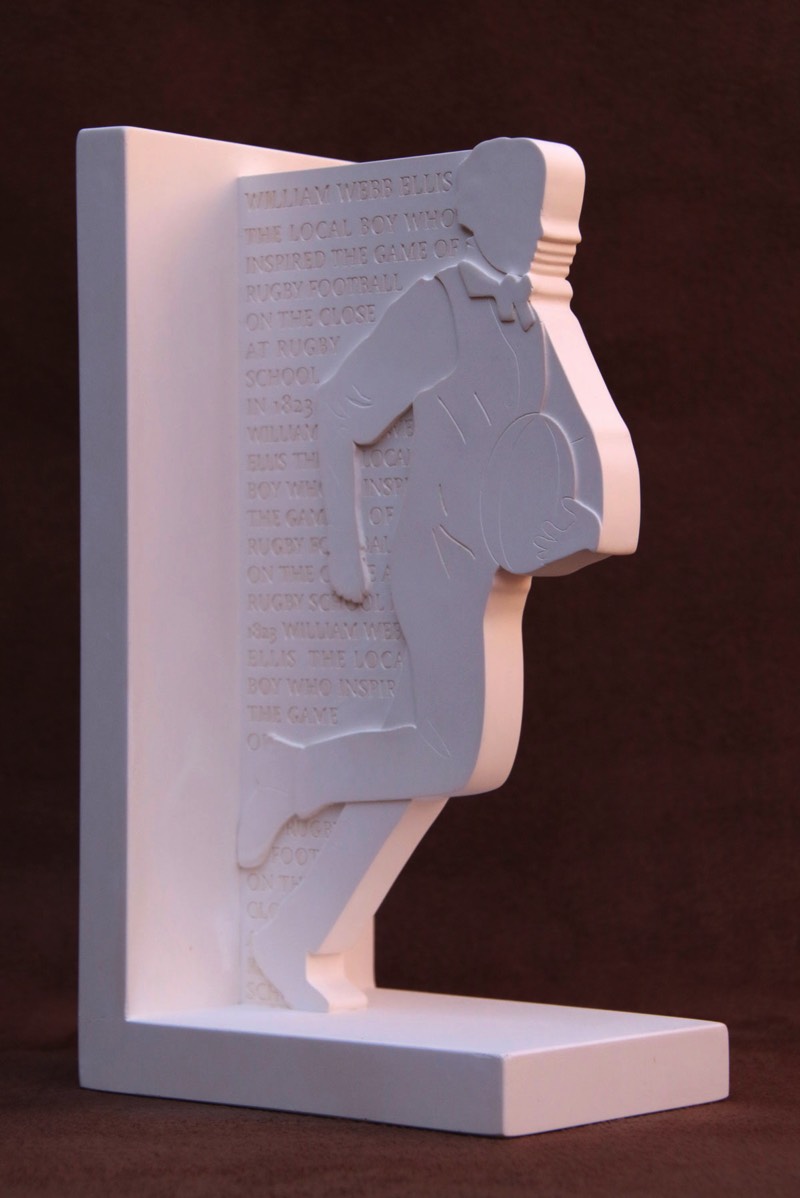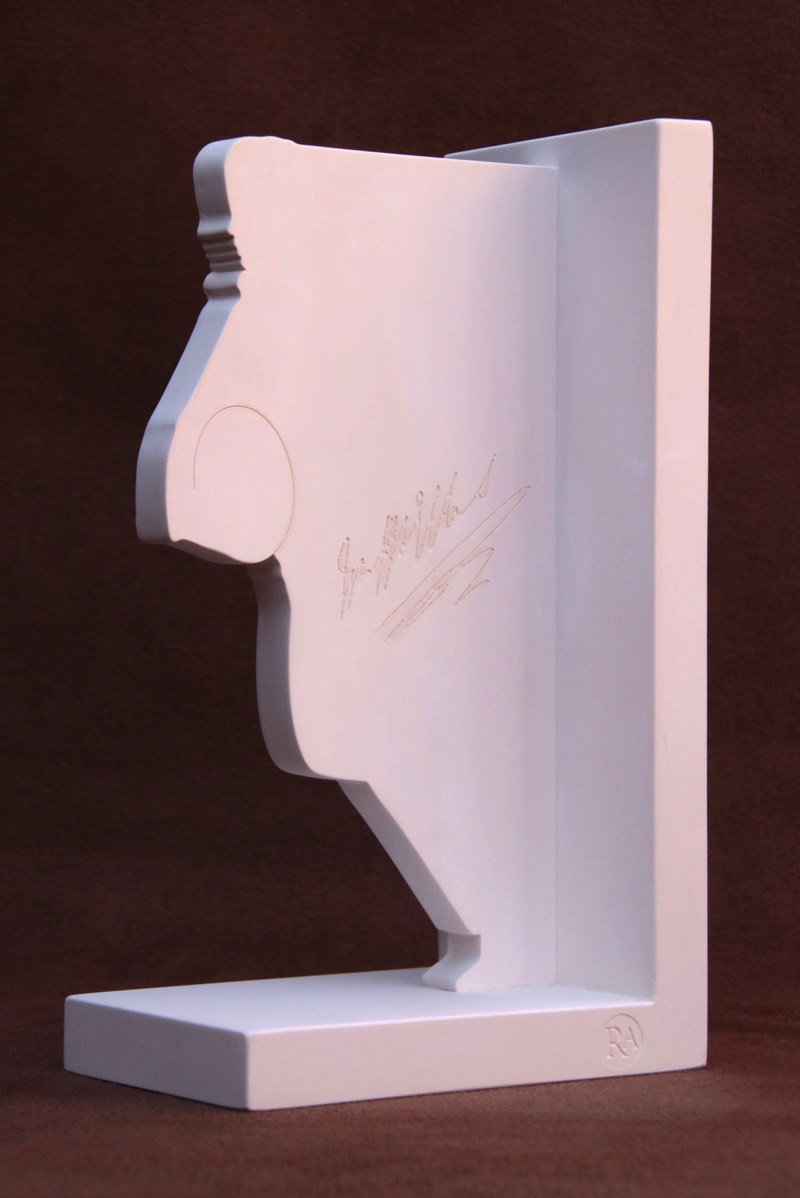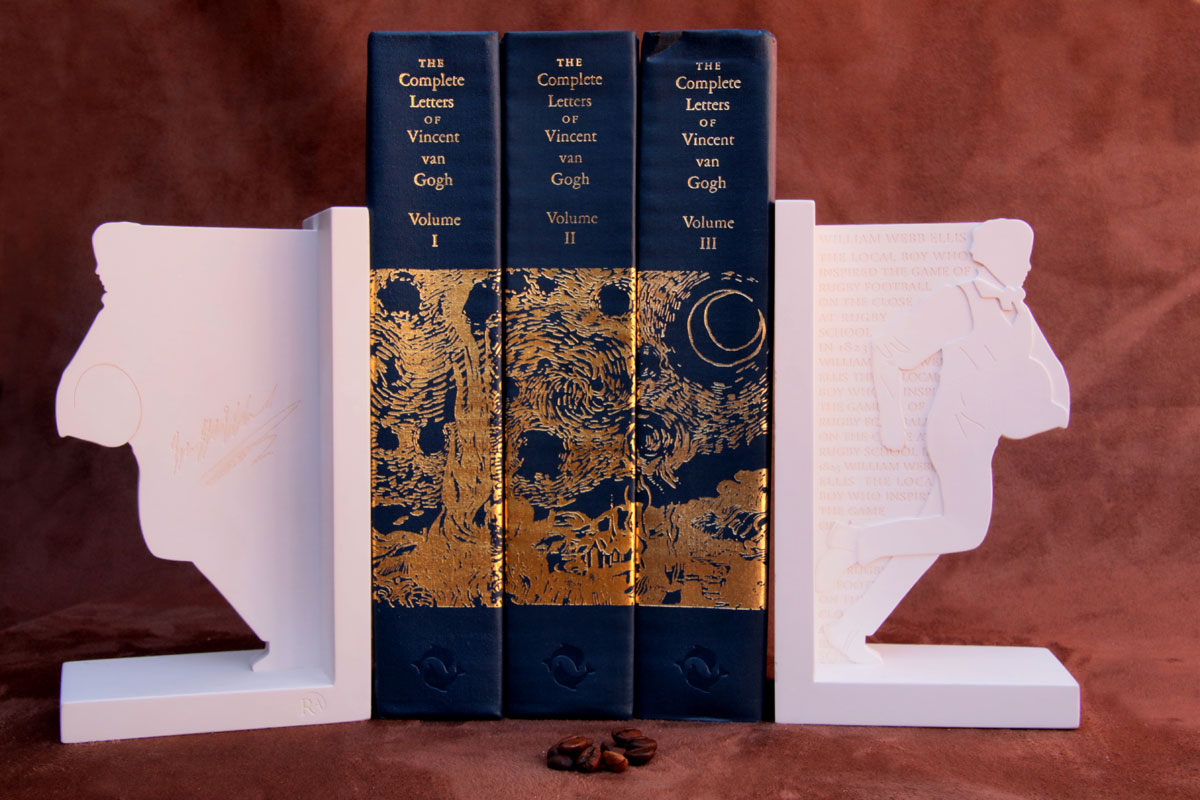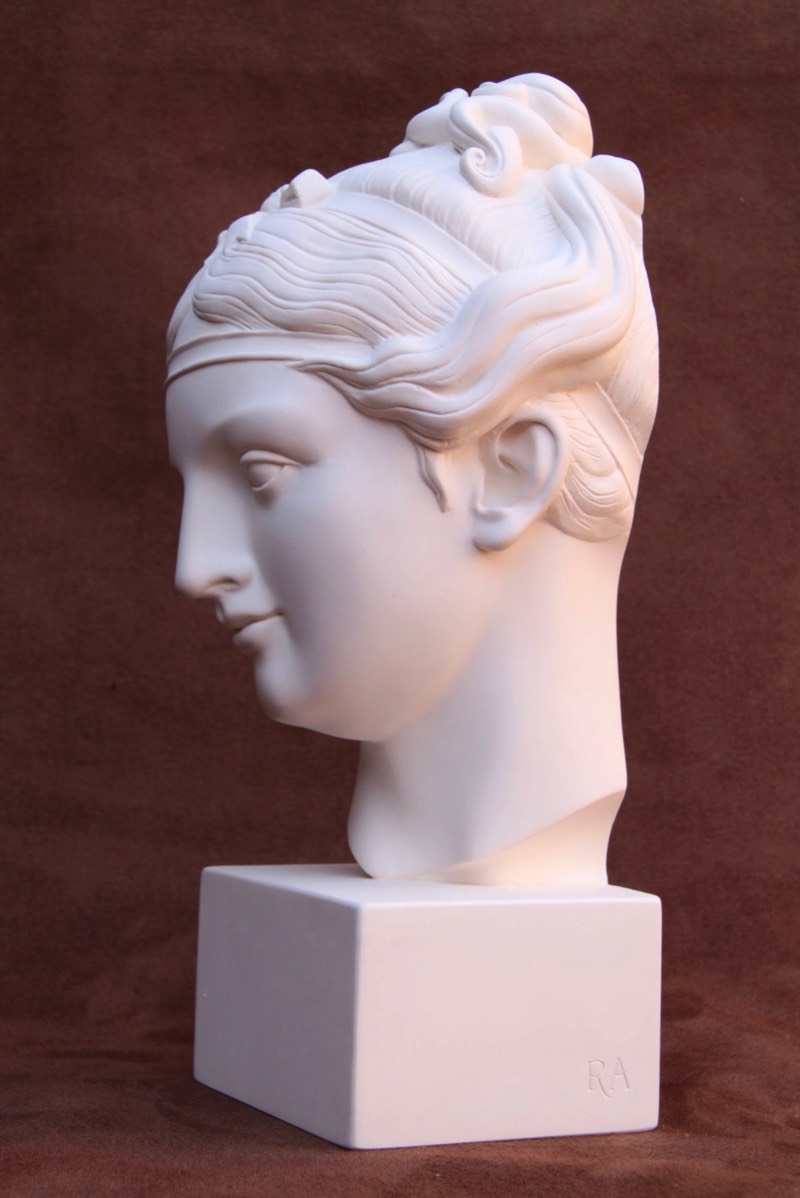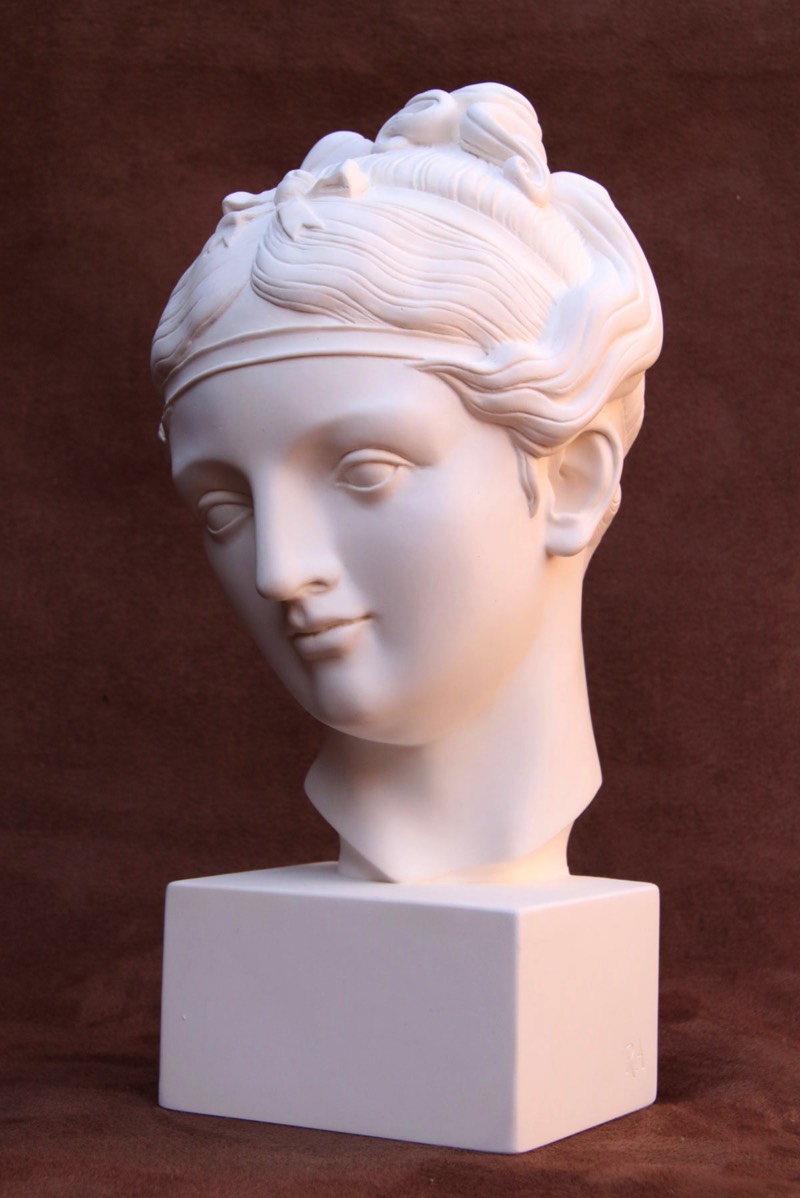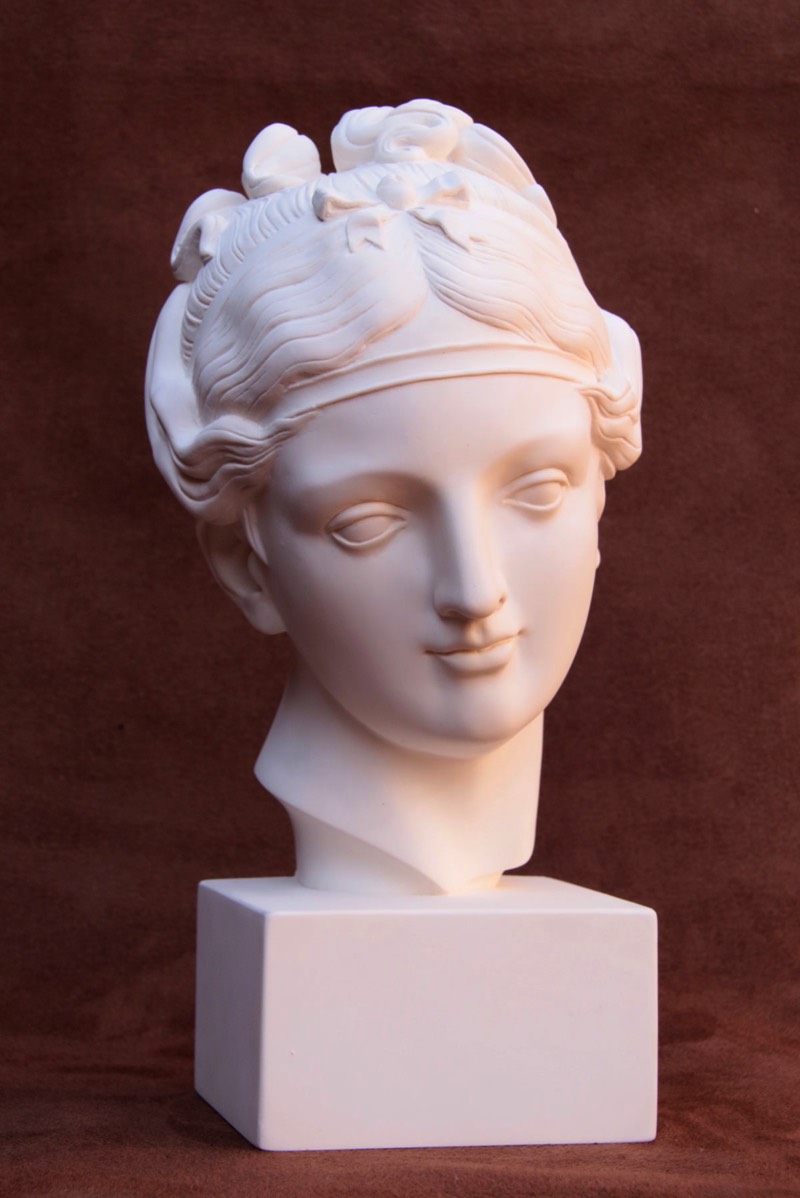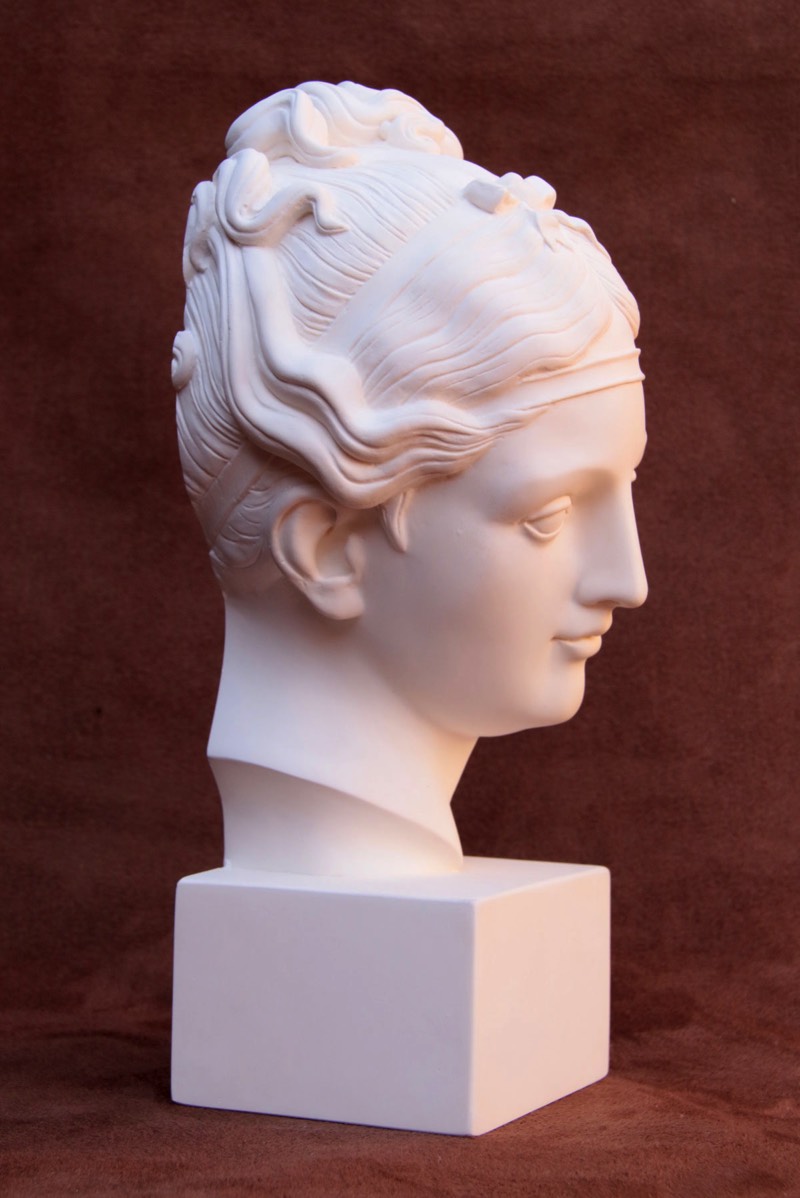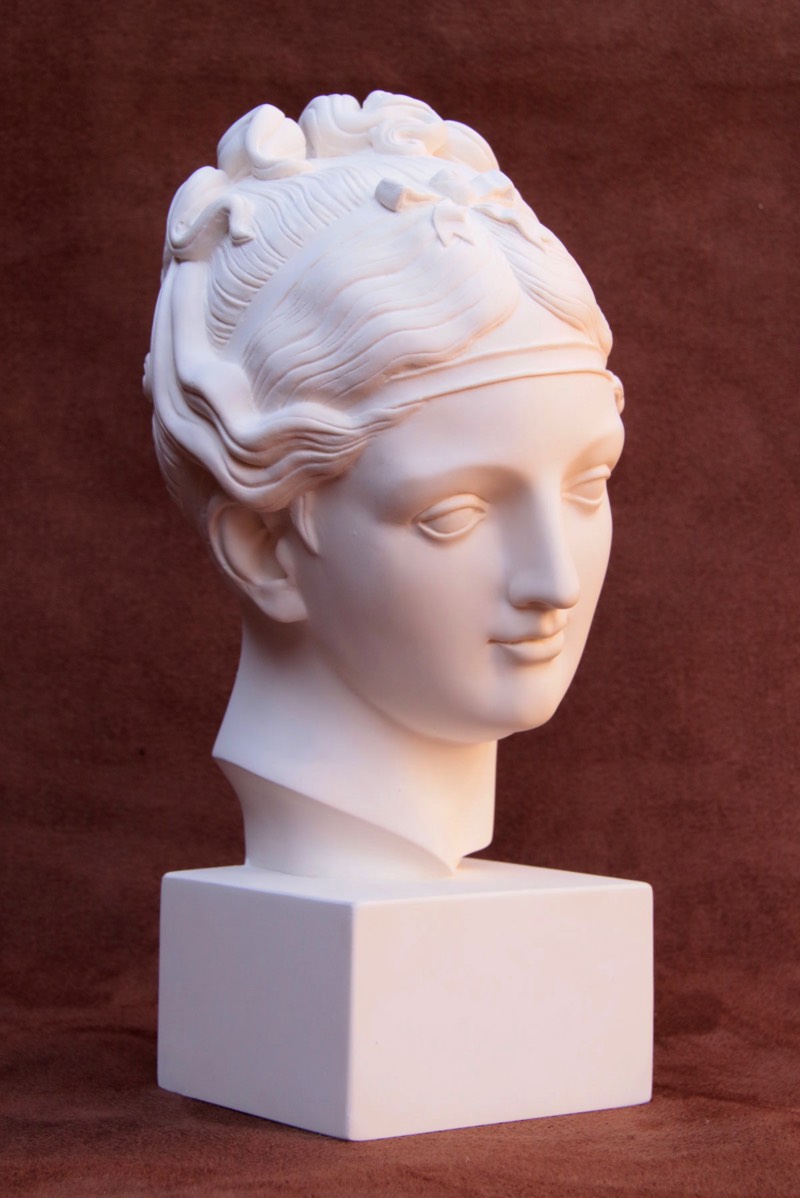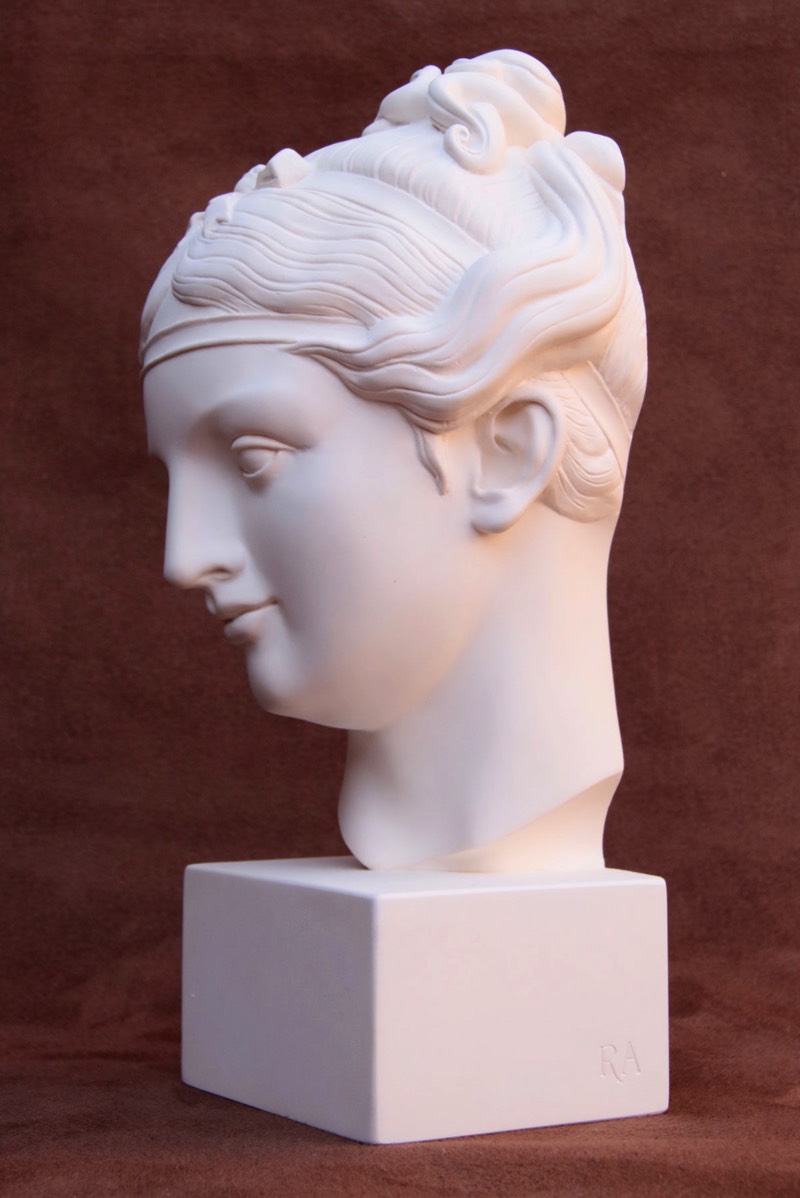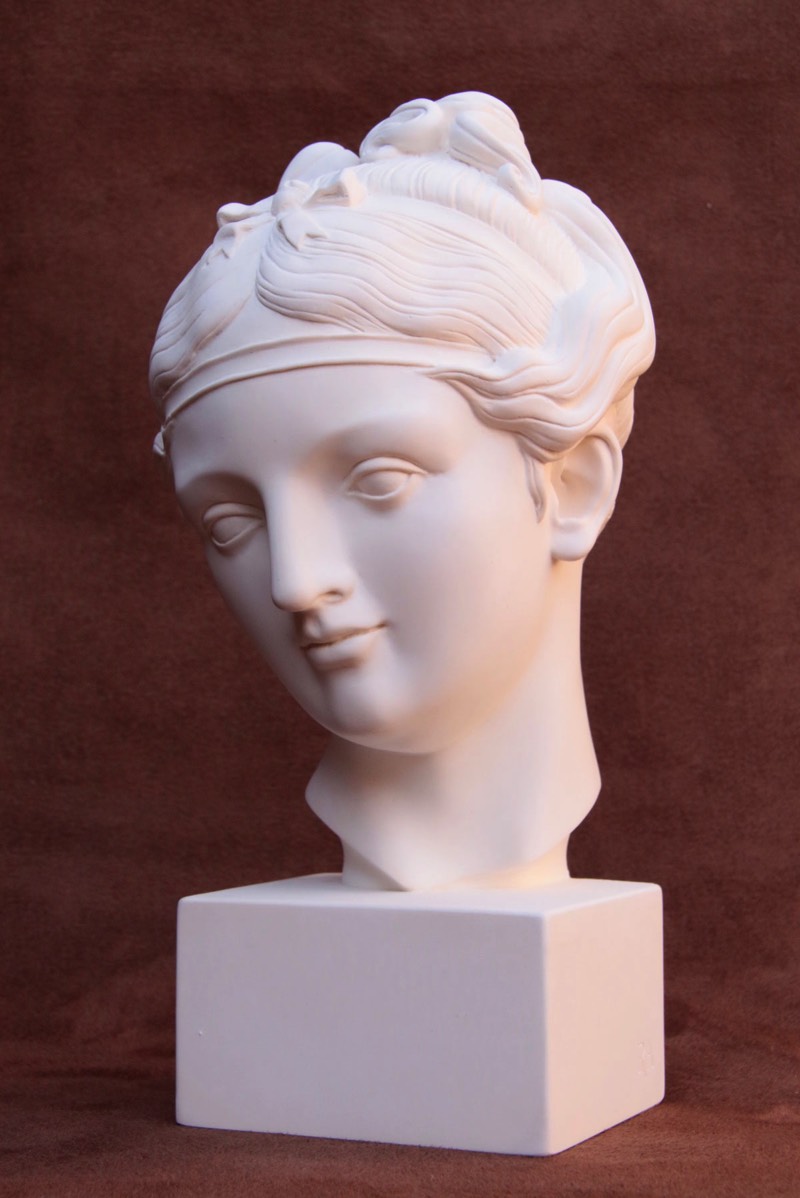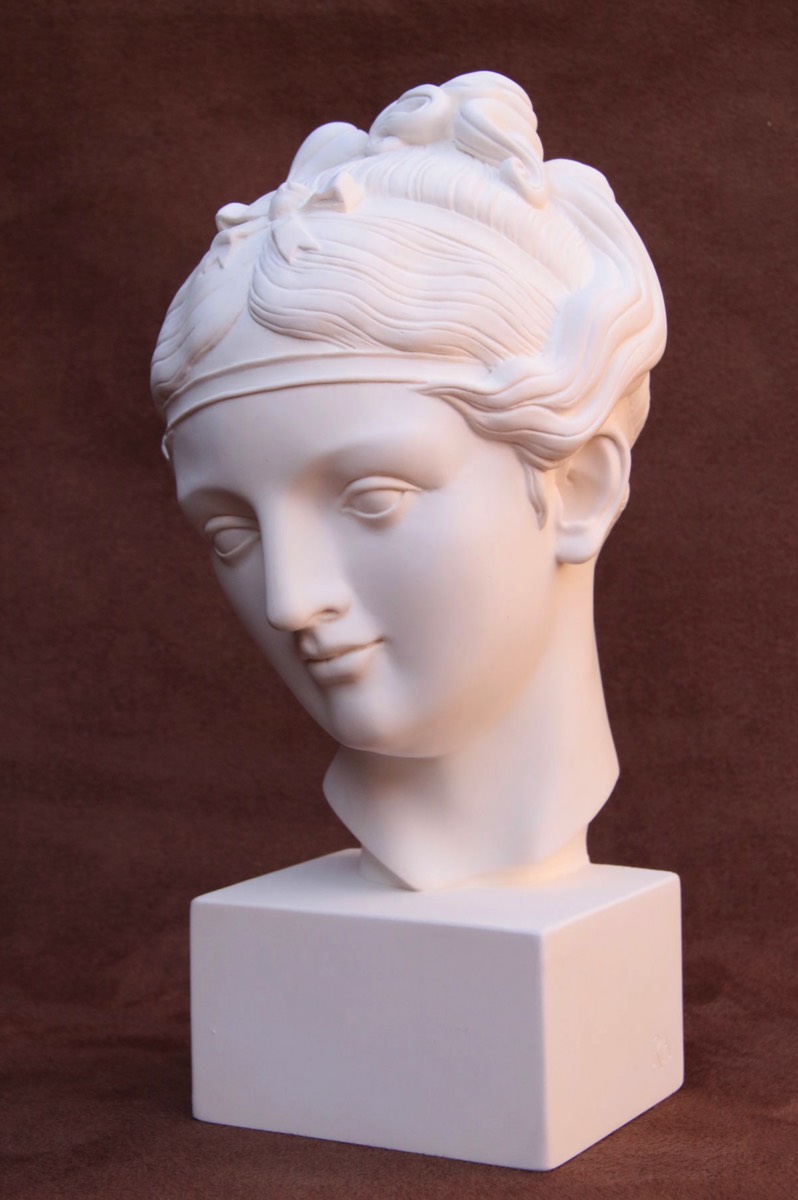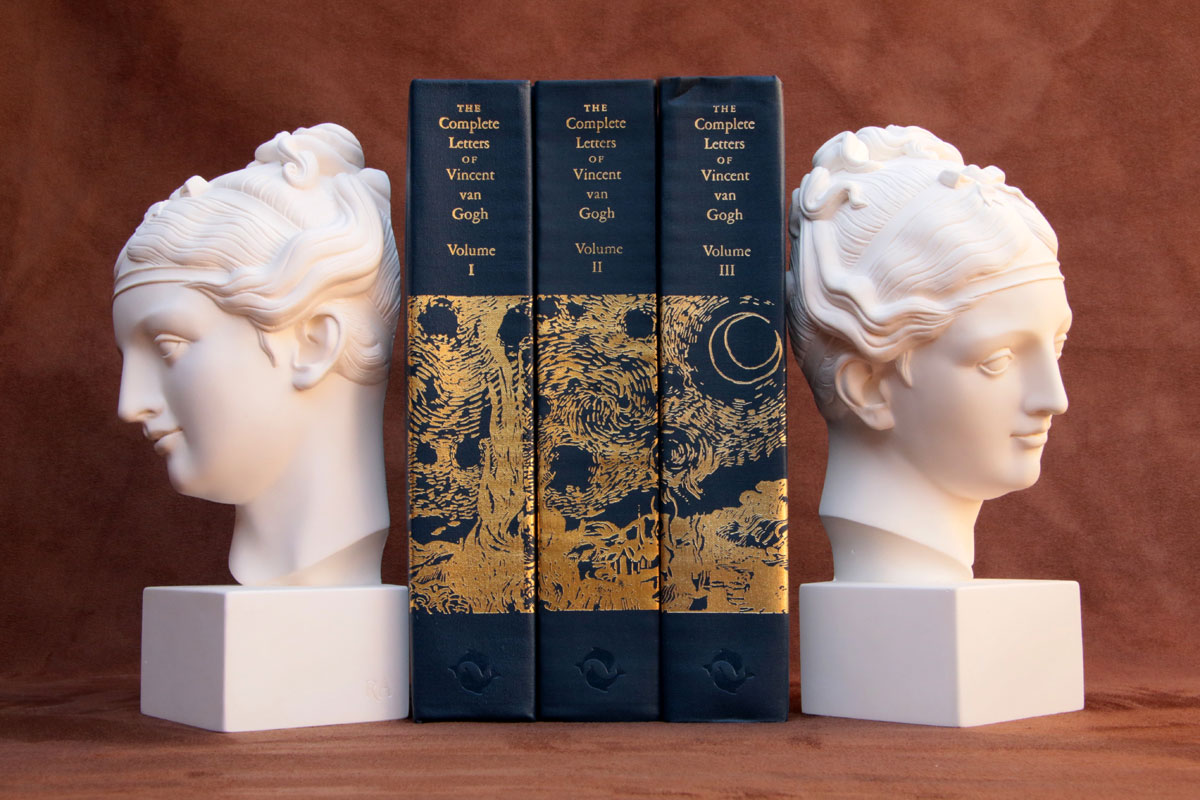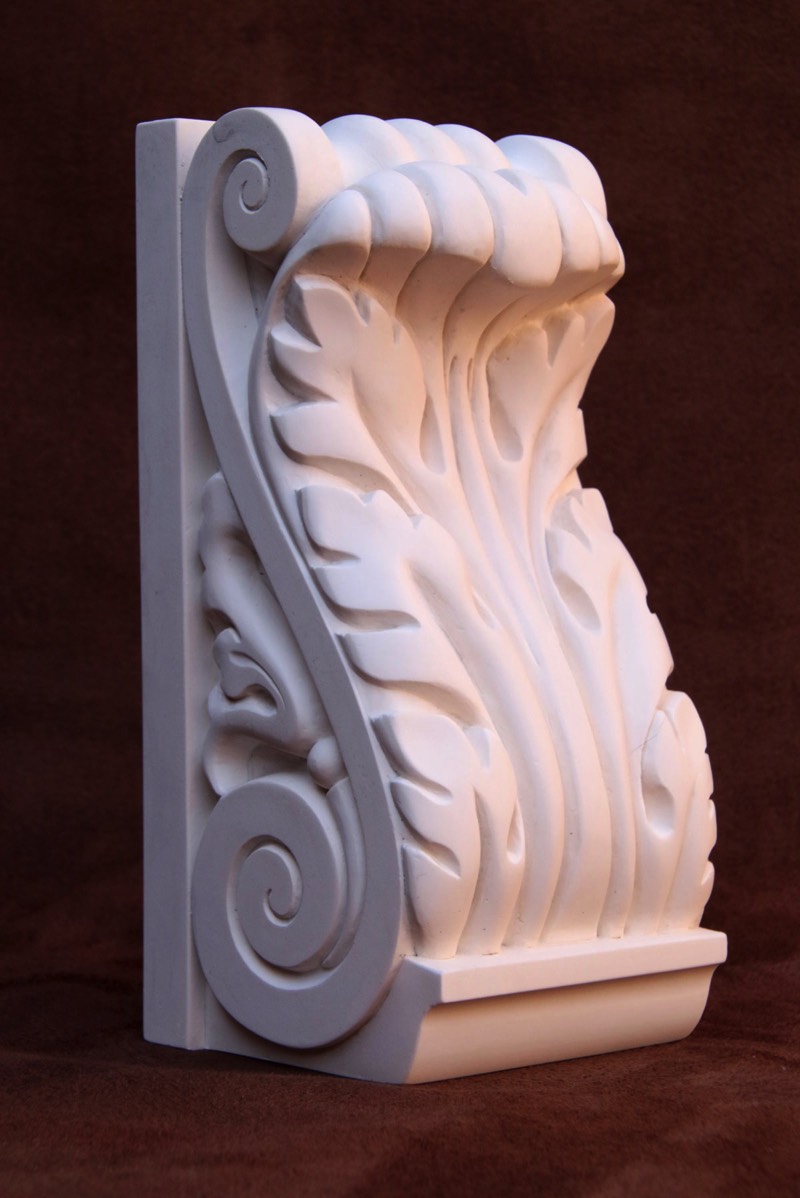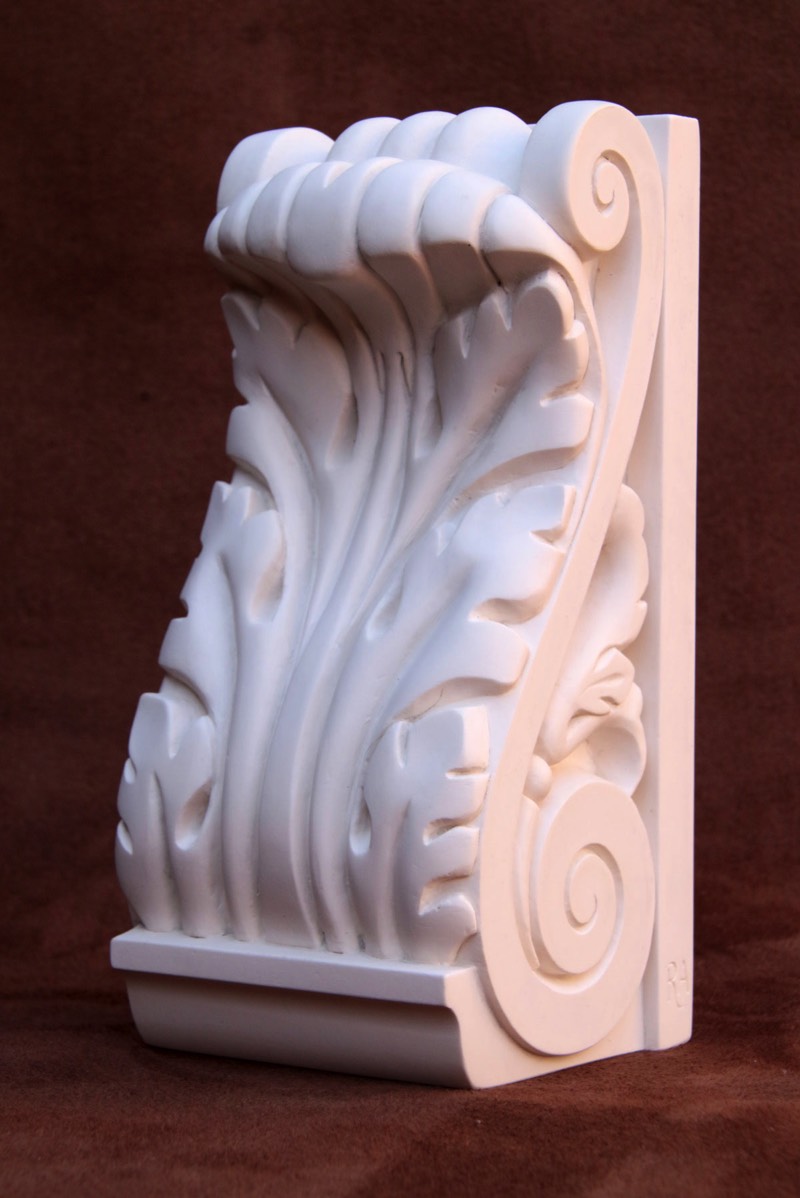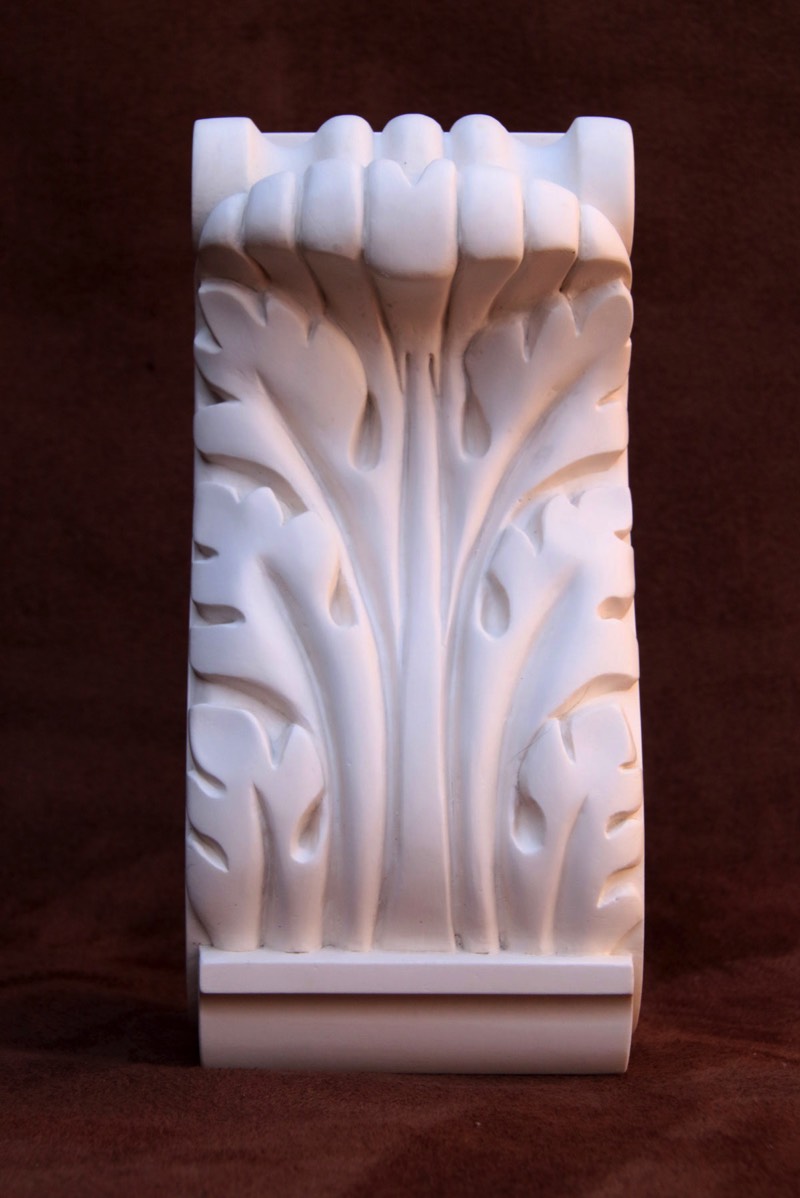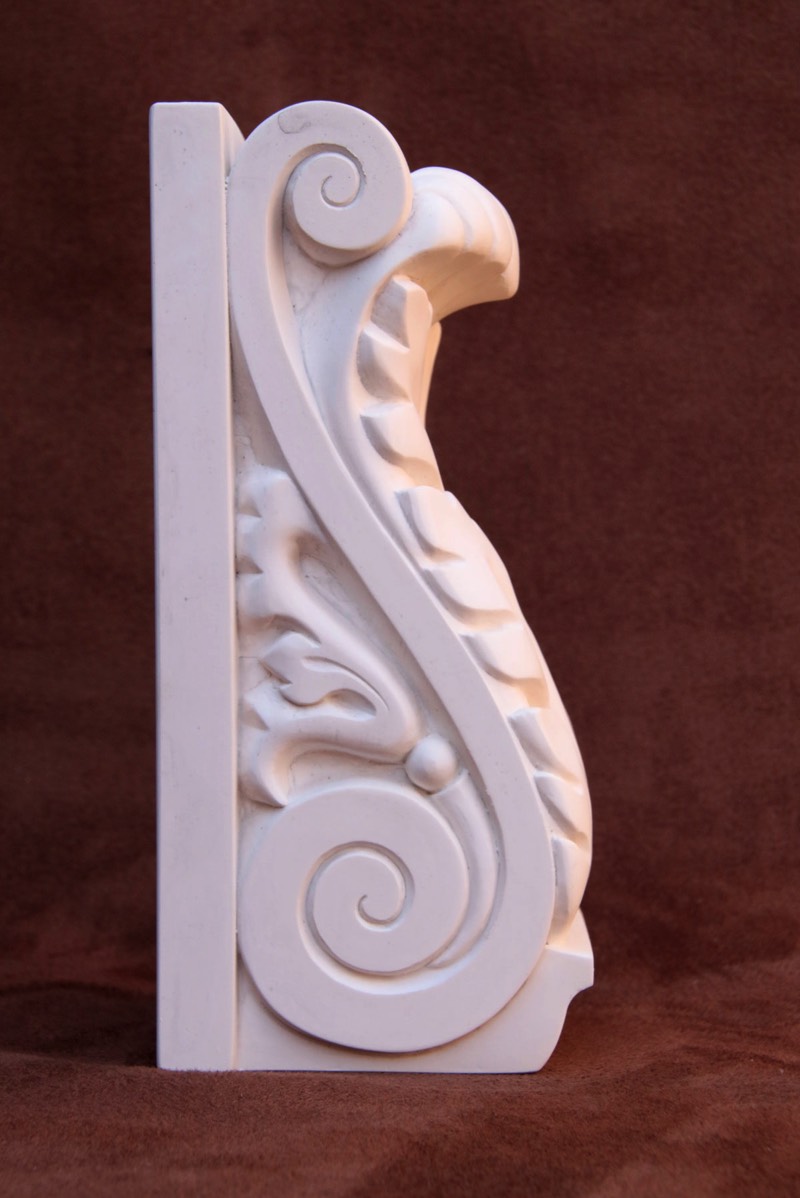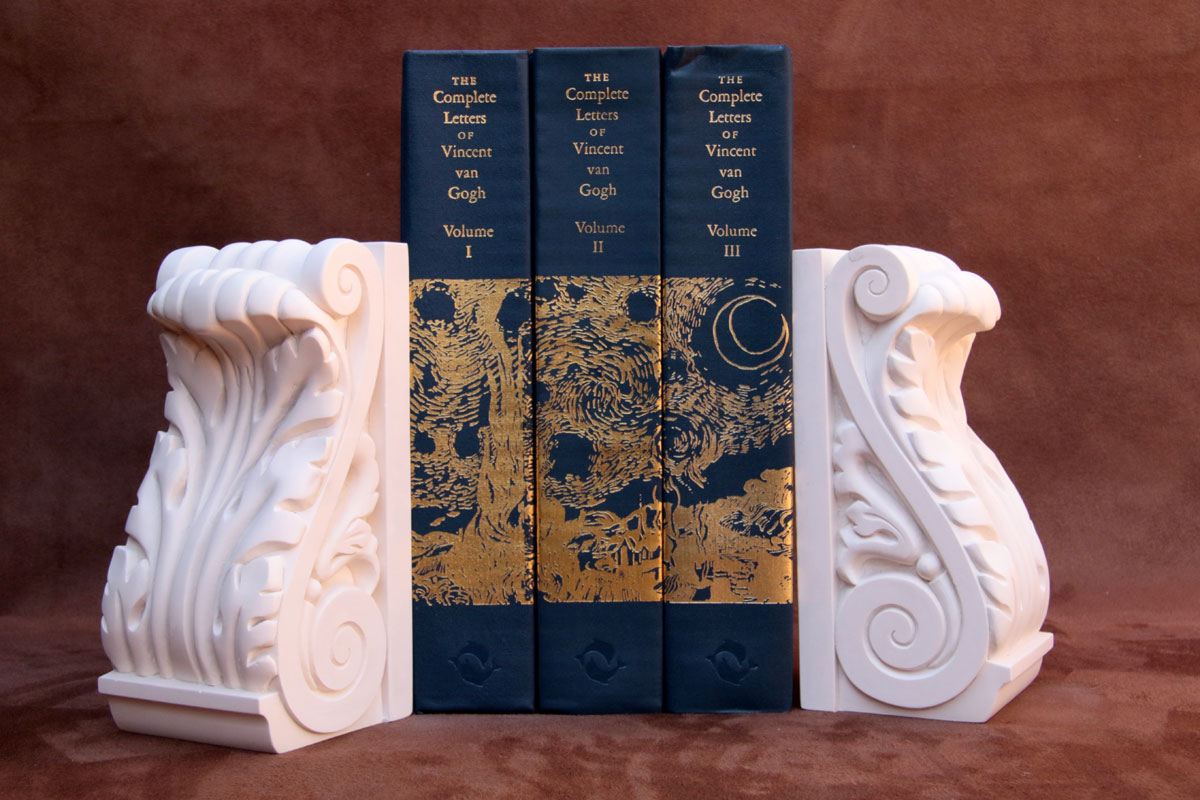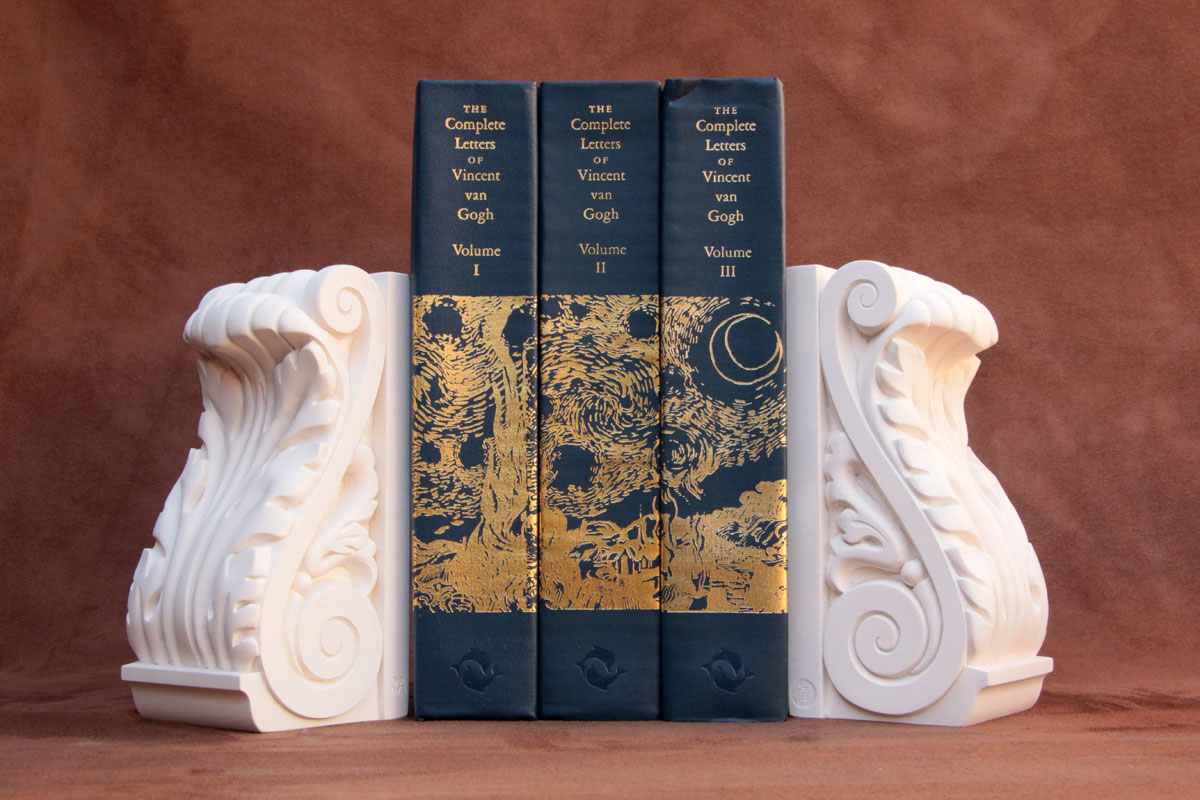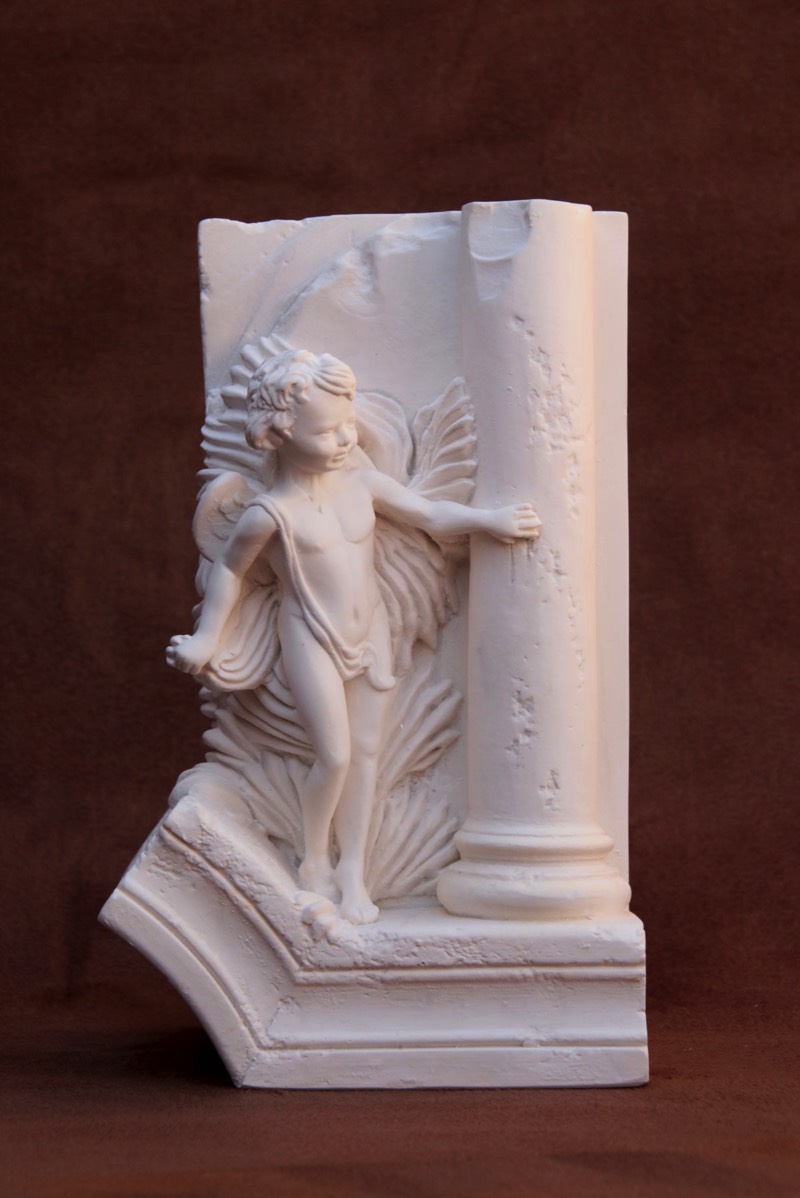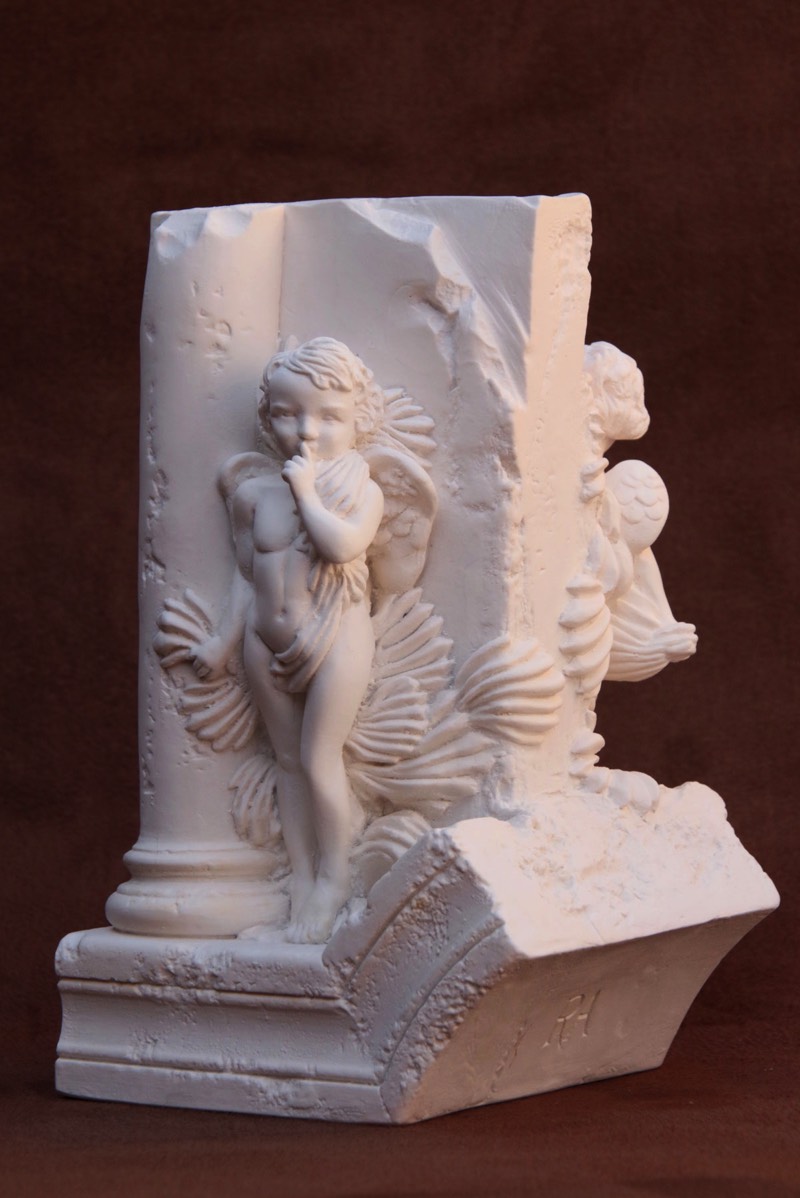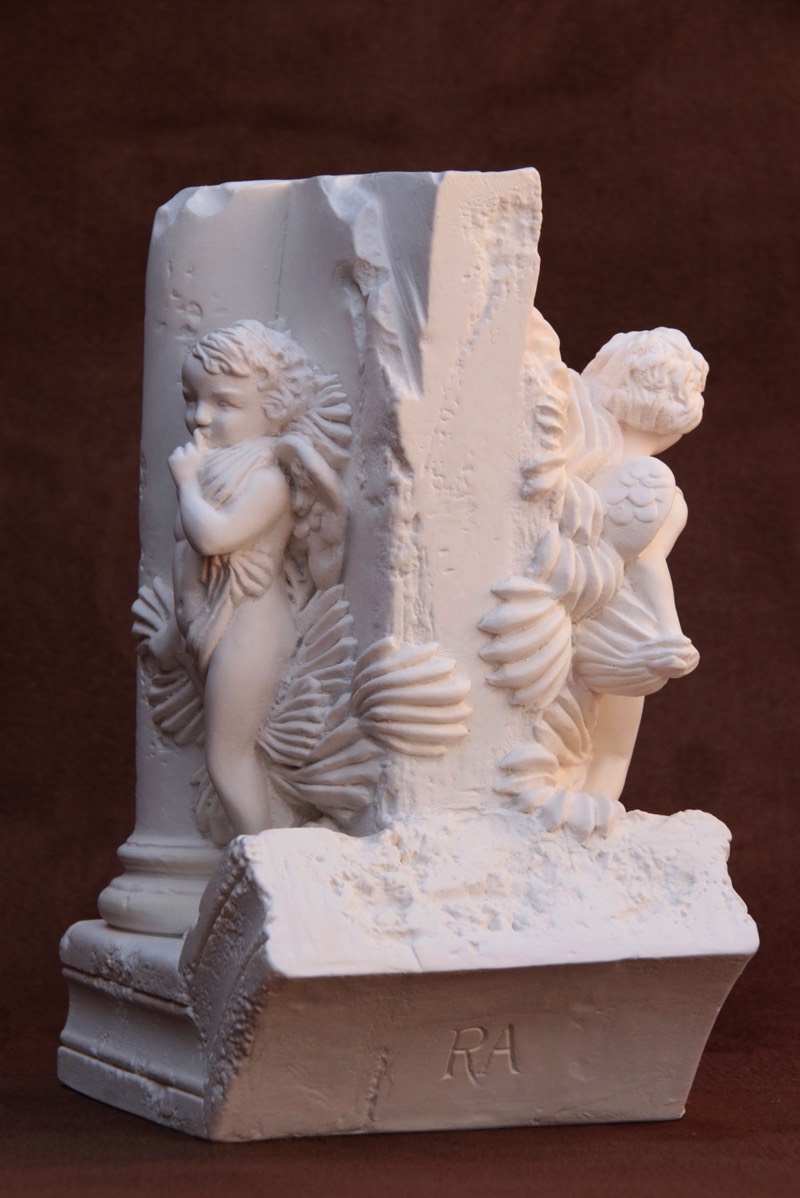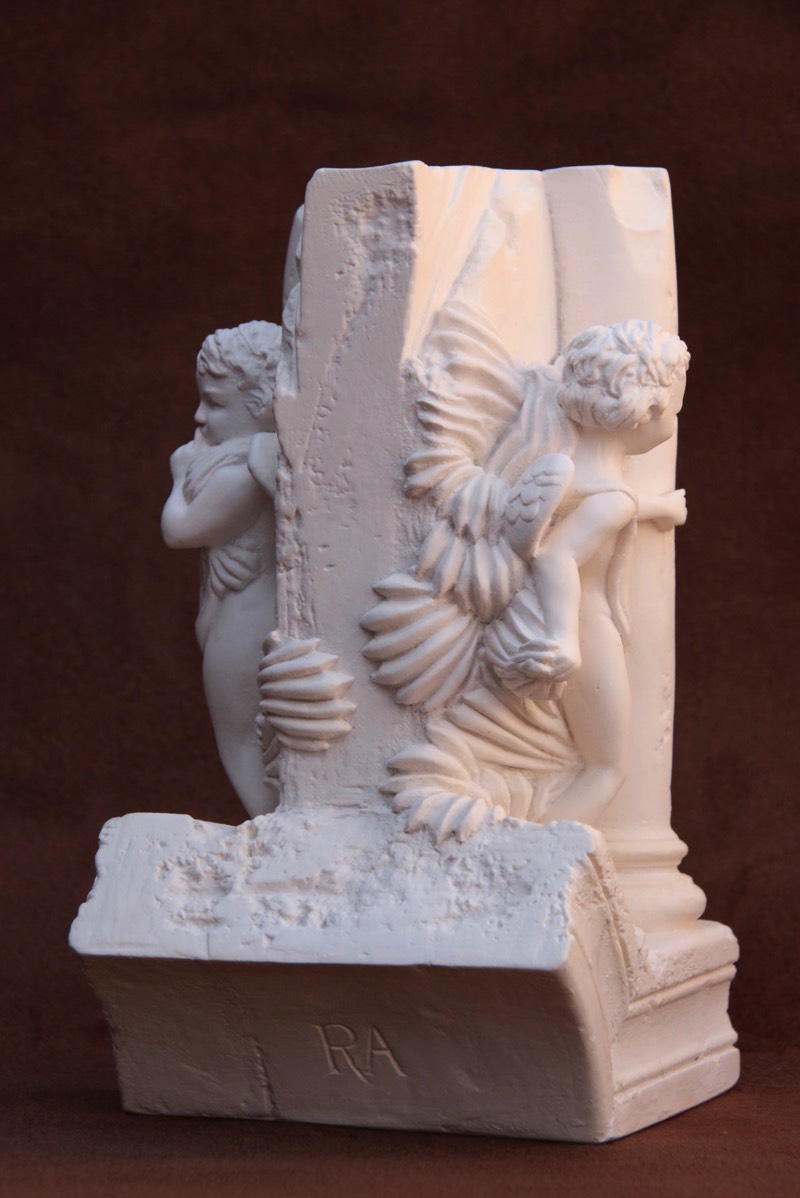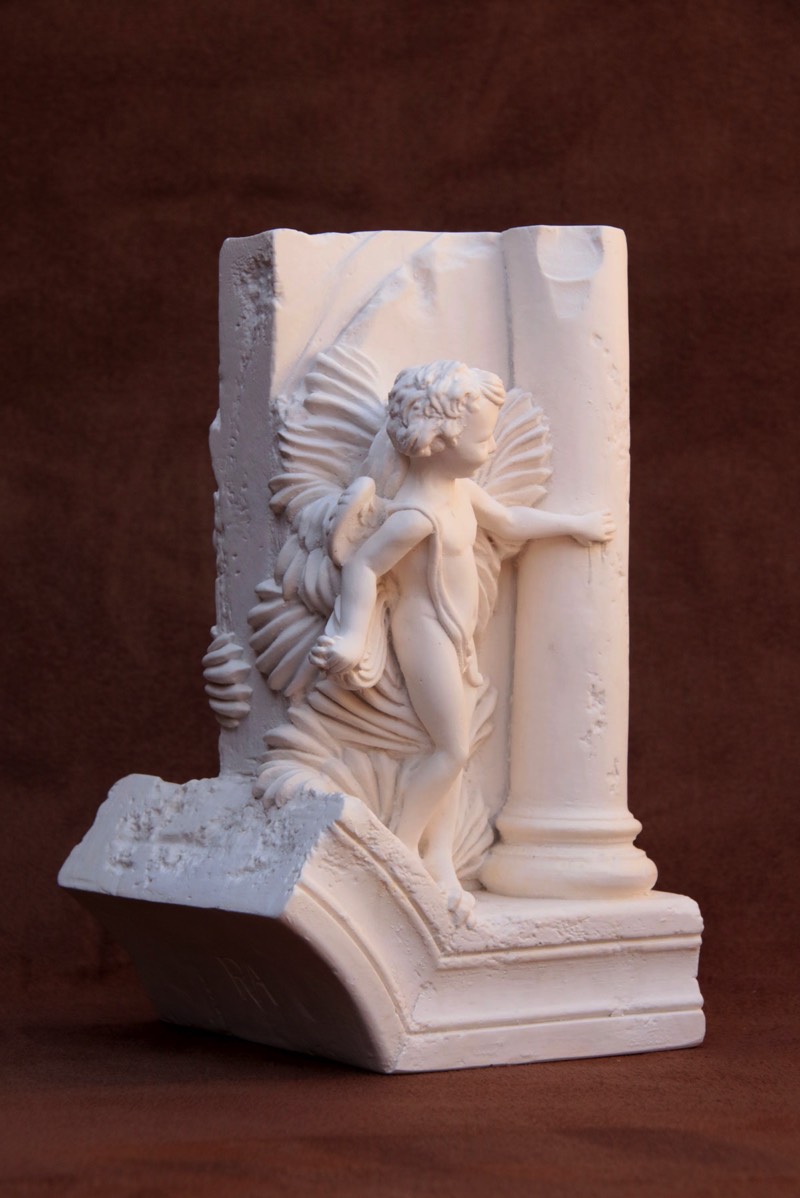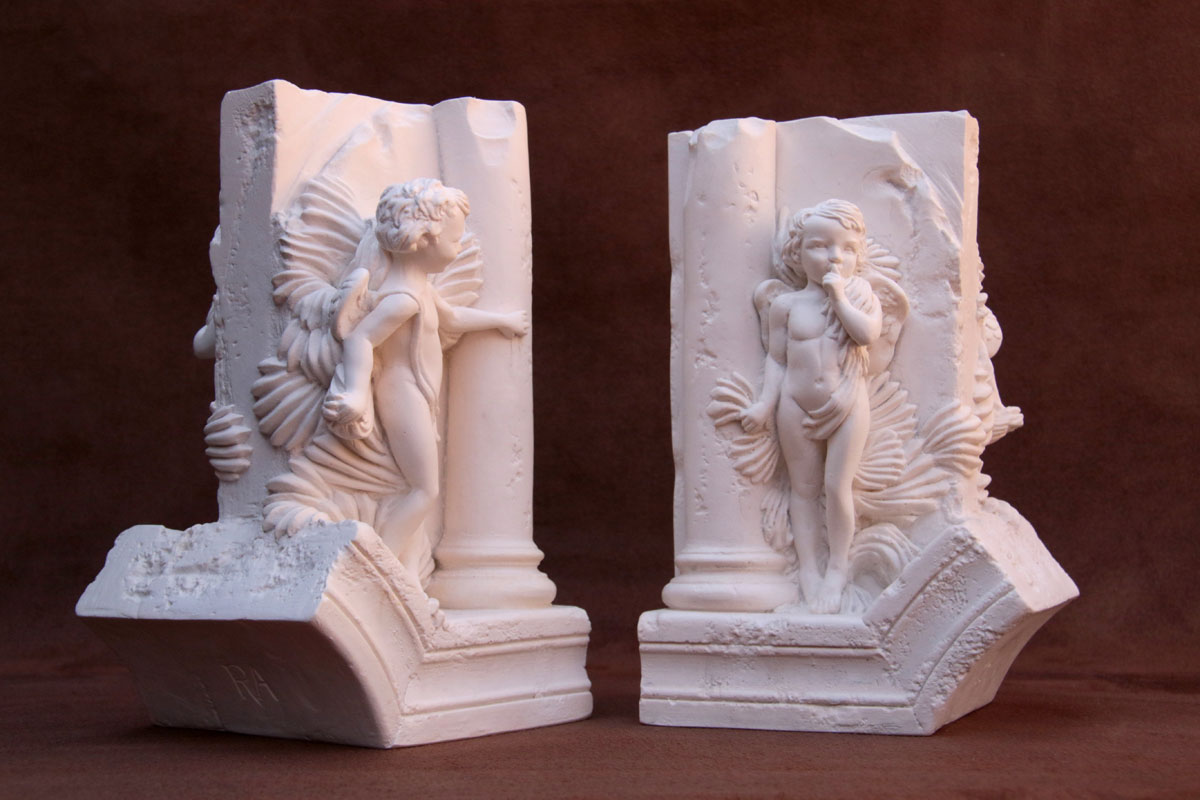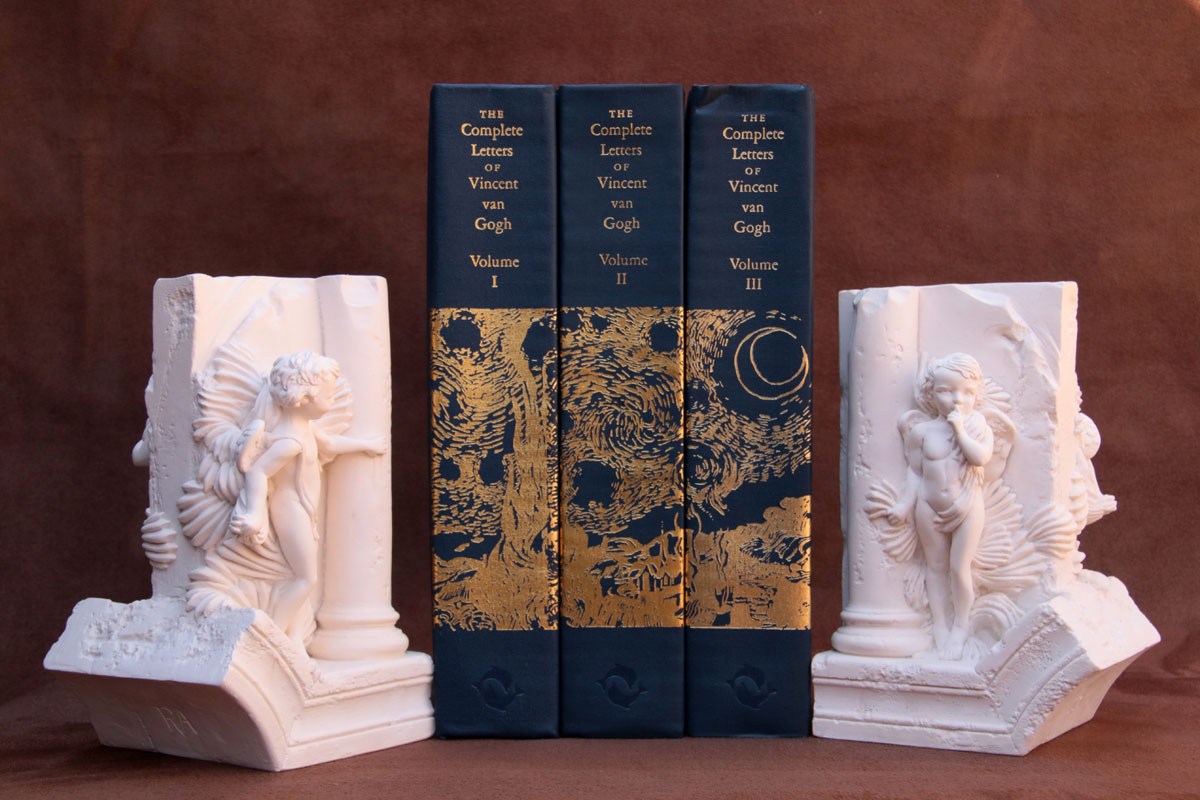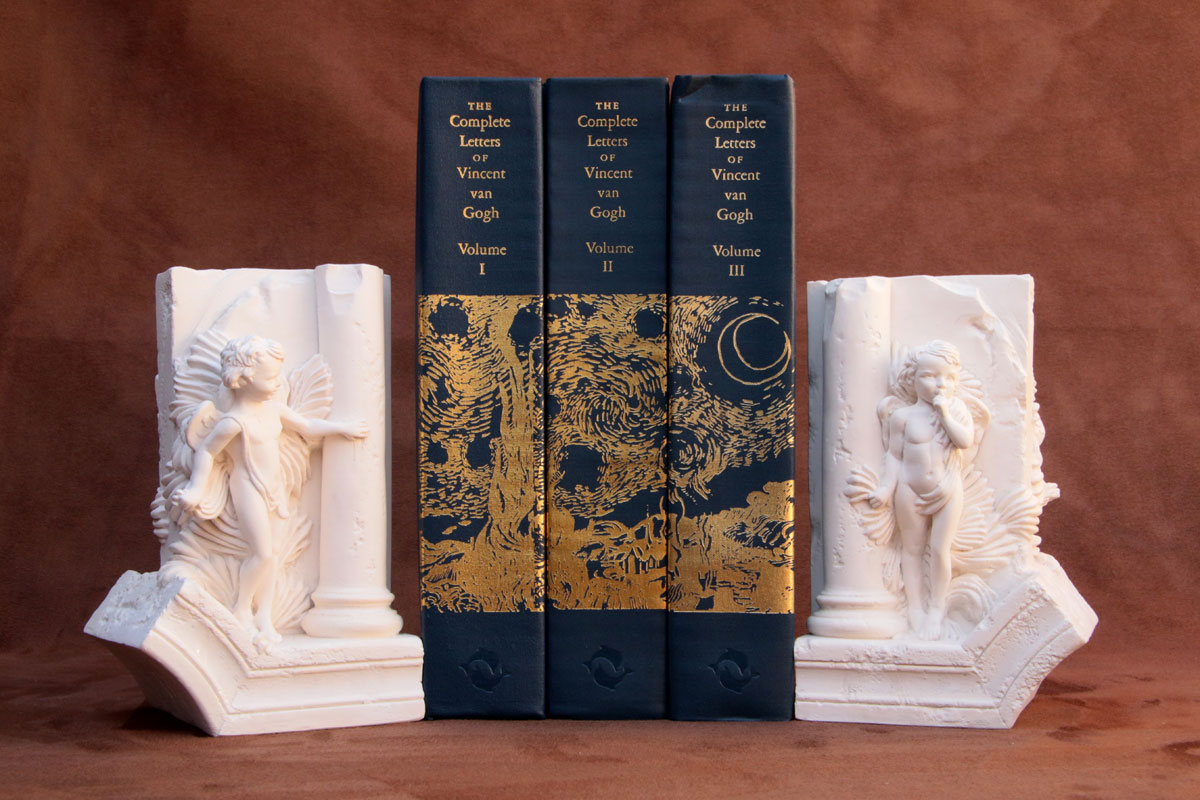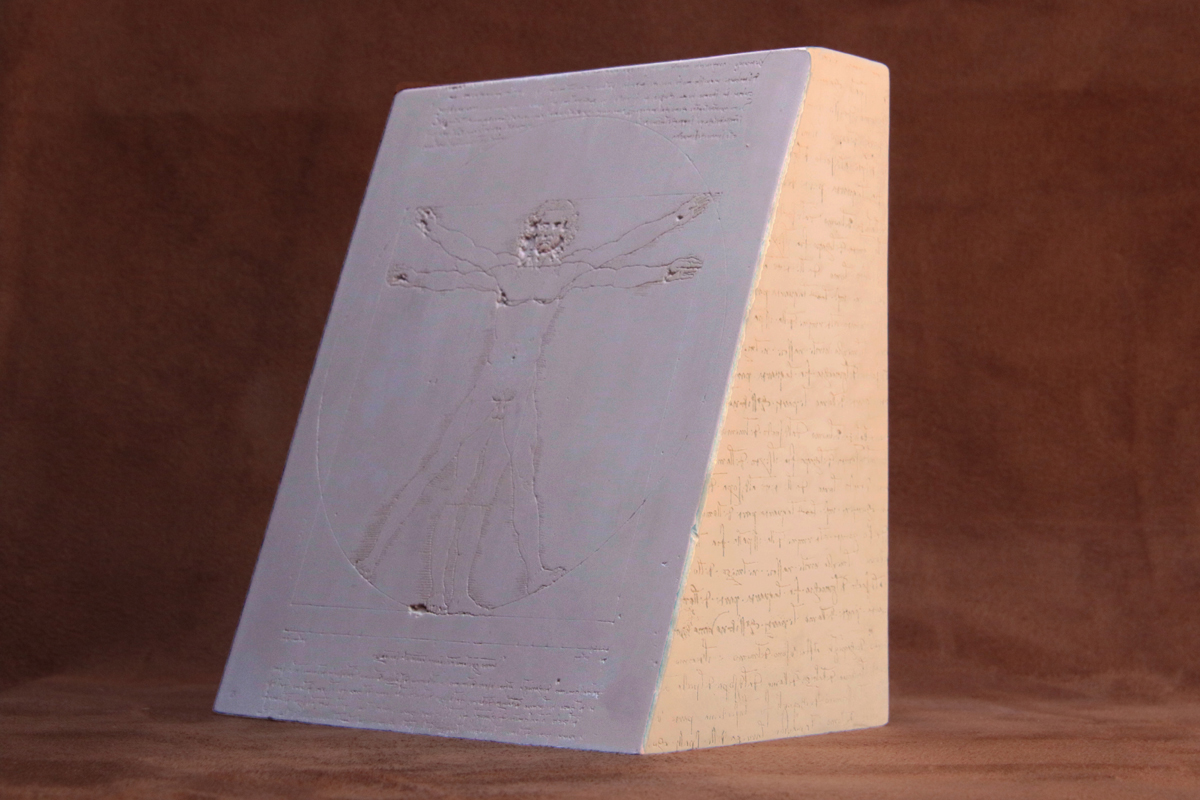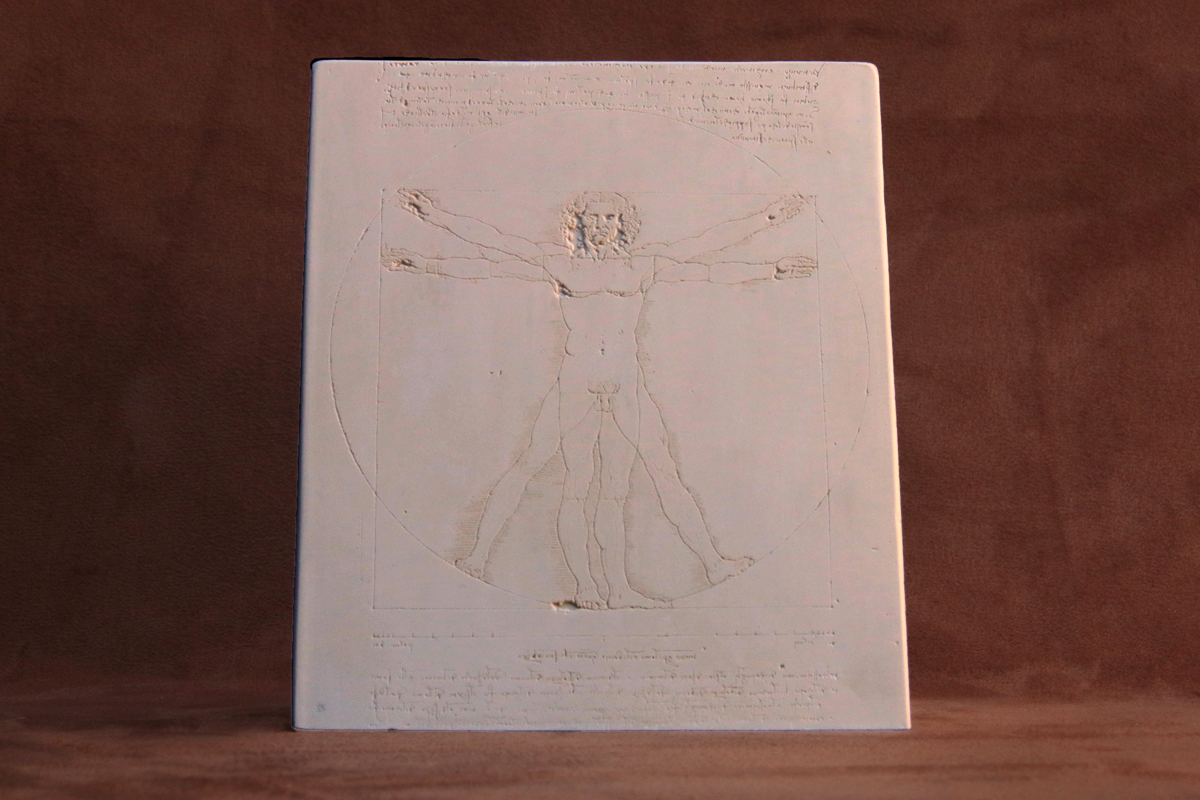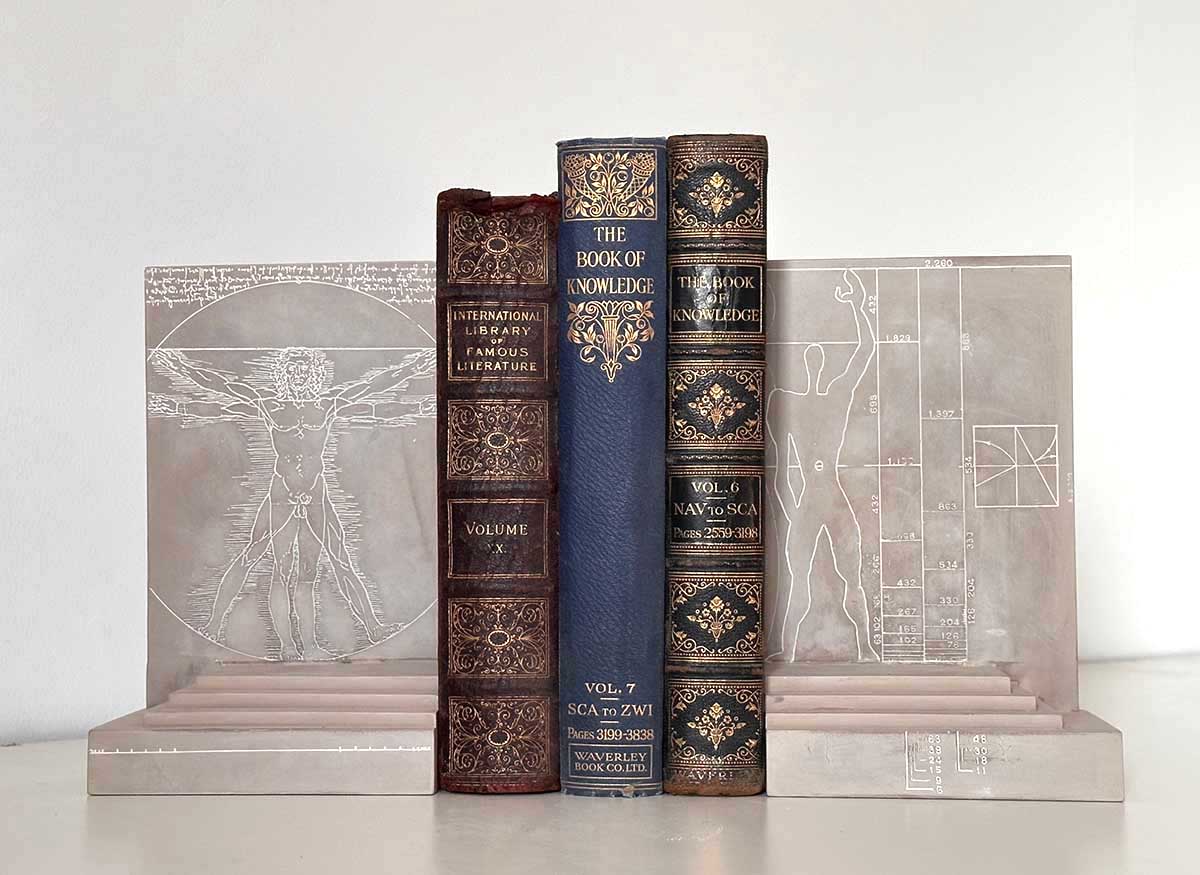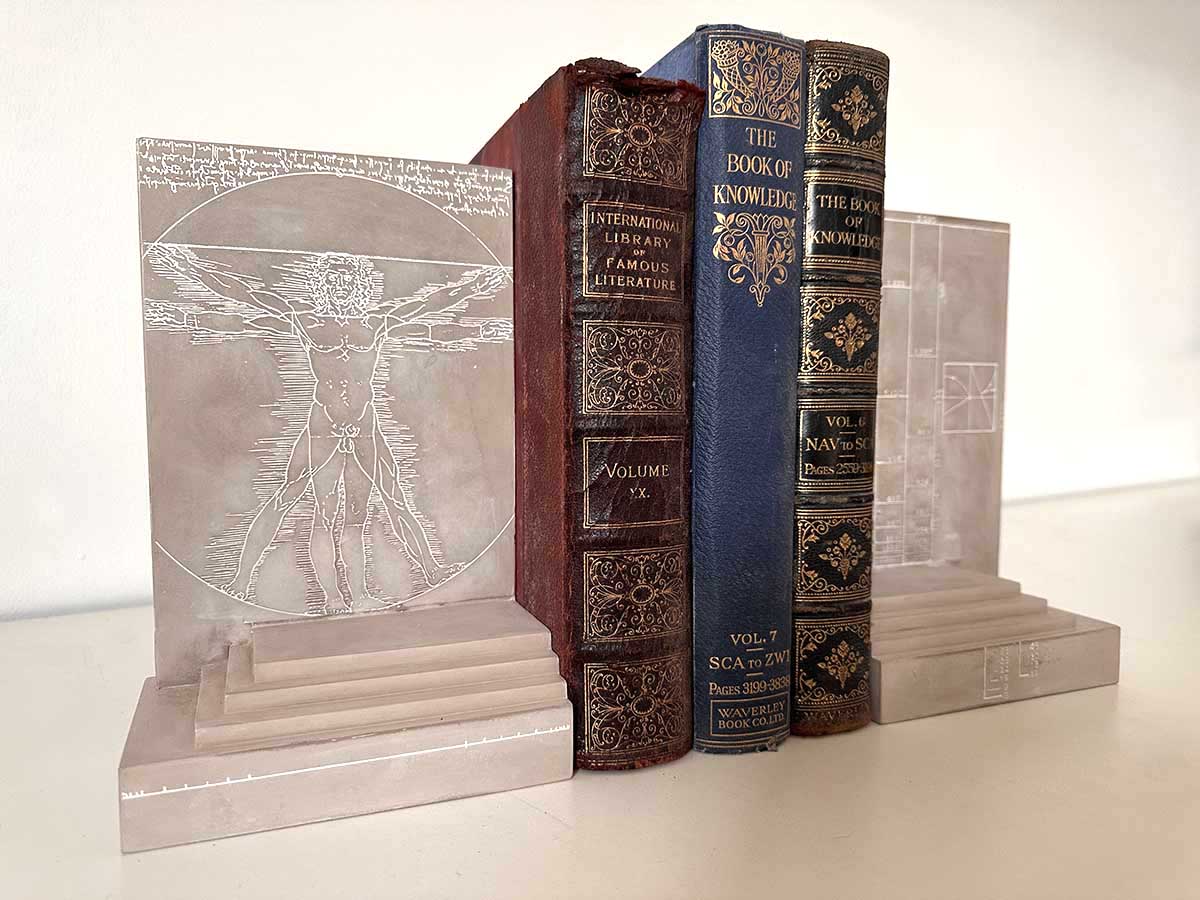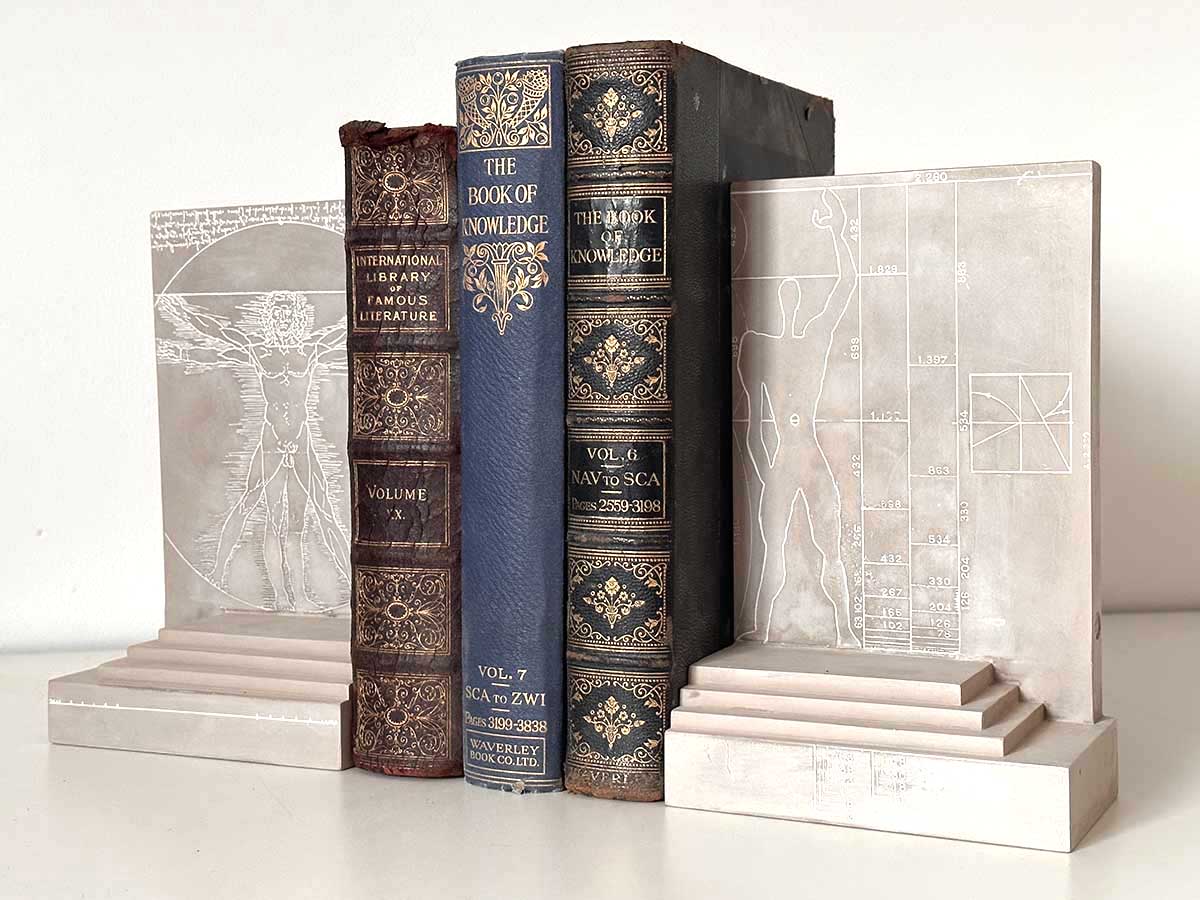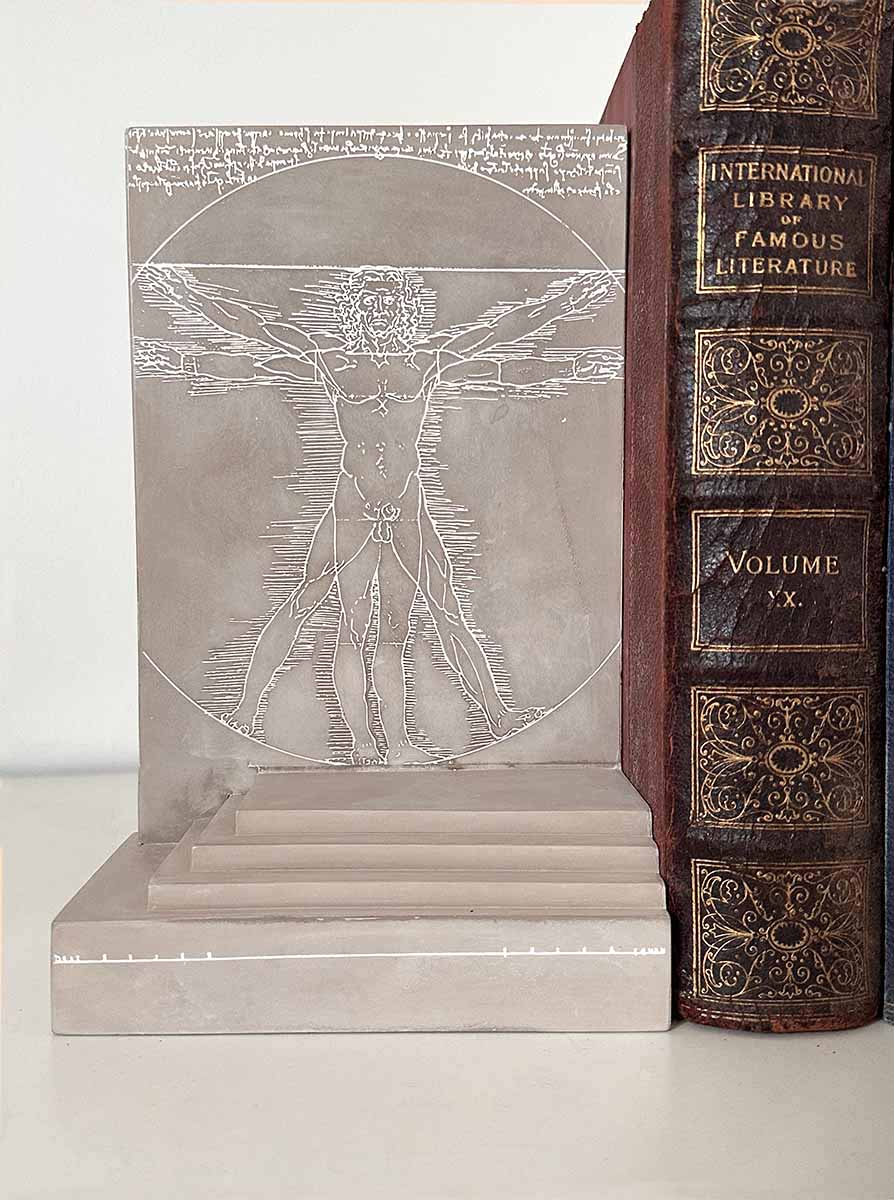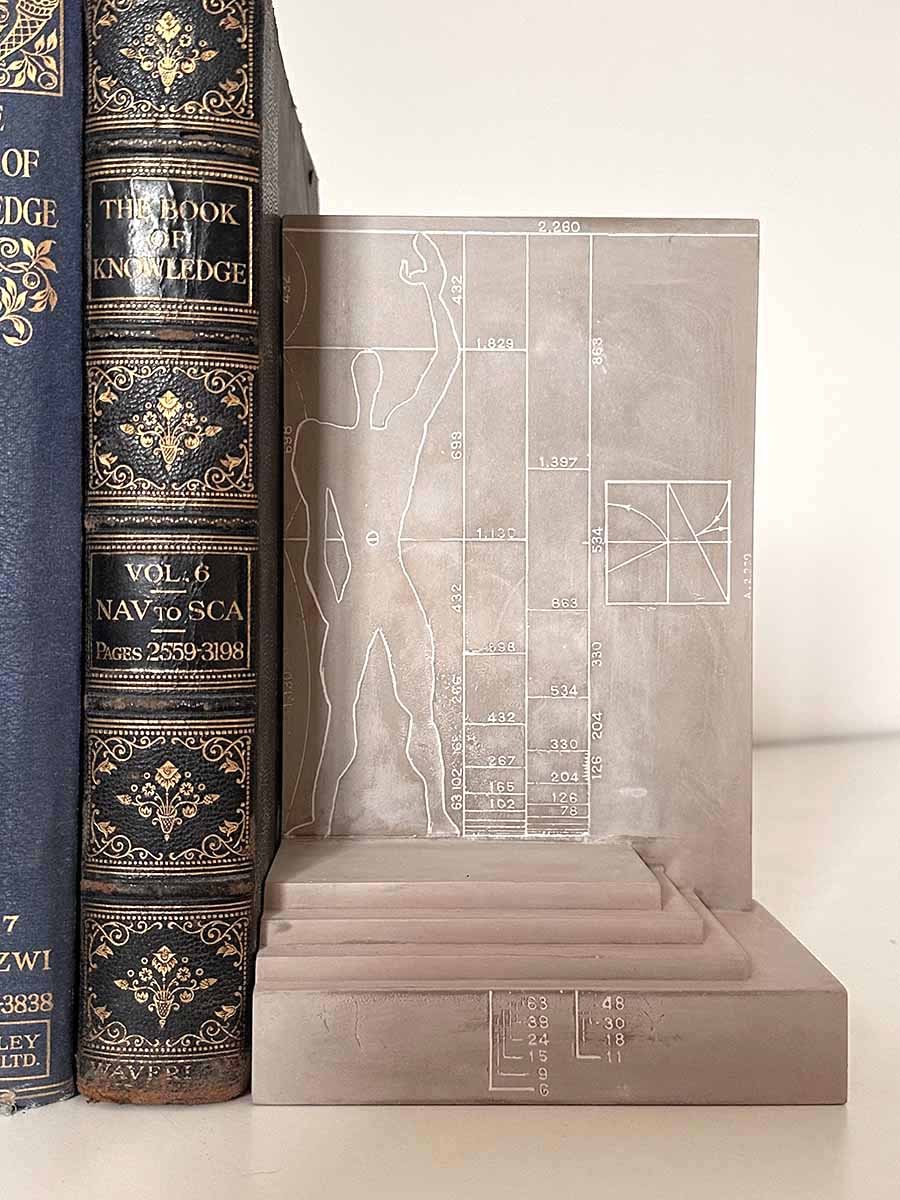
Bookends
Click on the image to enlarge.
Churchill Bookend (Single)
Sir Winston Leonard Spencer-Churchill (30 November 1874 – 24 January 1965) was a British politician, army officer, and writer, who was Prime Minister of the United Kingdom from 1940 to 1945 and again from 1951 to 1955.
Sir Winston Leonard Spencer-Churchill (30 November 1874 – 24 January 1965) was a British politician, army officer, and writer, who was Prime Minister of the United Kingdom from 1940 to 1945 and again from 1951 to 1955.
More Info
He won the Nobel Prize for Literature in 1953 for his lifetime body of work.
In 1963, he was the first of only eight people to be made an honorary citizen of the United States.
In his Speech to the House of Commons may 13th 1940 he uttered the immortal words - "...we shall defend our Island, whatever the cost may be...we shall never surrender."
Churchill is on of the most photographed, sculpted, painted and drawn figures in modern history. This original sculpture drew on this history and was made at our workshop in Bath.
As Prime Minister, Churchill led Britain to victory in the in the Second World War. Churchill represented five constituencies during his career as Member of Parliament (MP).
Ideologically an Economic Liberal and British Imperialist, he began and ended his parliamentary career as a member of the Conservative Party, which he led from 1940 to 1955, but for twenty years from 1904 he was a prominent member of the Liberal Party.
This bookend is inscribed on one side with Winston Churchill's signature.
The other features the great Briton’s 'We shall never surrender speech,' made to the House of Commons June 1940.
Height 17cm
In 1963, he was the first of only eight people to be made an honorary citizen of the United States.
In his Speech to the House of Commons may 13th 1940 he uttered the immortal words - "...we shall defend our Island, whatever the cost may be...we shall never surrender."
Churchill is on of the most photographed, sculpted, painted and drawn figures in modern history. This original sculpture drew on this history and was made at our workshop in Bath.
As Prime Minister, Churchill led Britain to victory in the in the Second World War. Churchill represented five constituencies during his career as Member of Parliament (MP).
Ideologically an Economic Liberal and British Imperialist, he began and ended his parliamentary career as a member of the Conservative Party, which he led from 1940 to 1955, but for twenty years from 1904 he was a prominent member of the Liberal Party.
This bookend is inscribed on one side with Winston Churchill's signature.
The other features the great Briton’s 'We shall never surrender speech,' made to the House of Commons June 1940.
Height 17cm
Click on the image to enlarge.
Churchill Bookend
(Set of 2)
Sir Winston Leonard Spencer-Churchill (30 November 1874 – 24 January 1965) was a British politician, army officer, and writer, who was Prime Minister of the United Kingdom from 1940 to 1945 and again from 1951 to 1955.
(Set of 2)
Sir Winston Leonard Spencer-Churchill (30 November 1874 – 24 January 1965) was a British politician, army officer, and writer, who was Prime Minister of the United Kingdom from 1940 to 1945 and again from 1951 to 1955.
More Info
He won the Nobel Prize for Literature in 1953 for his lifetime body of work.
In 1963, he was the first of only eight people to be made an honorary citizen of the United States.
In his Speech to the House of Commons may 13th 1940 he uttered the immortal words - "...we shall defend our Island, whatever the cost may be...we shall never surrender."
Churchill is on of the most photographed, sculpted, painted and drawn figures in modern history. This original sculpture drew on this history and was made at our workshop in Bath.
As Prime Minister, Churchill led Britain to victory in the in the Second World War. Churchill represented five constituencies during his career as Member of Parliament (MP).
Ideologically an Economic Liberal and British Imperialist, he began and ended his parliamentary career as a member of the Conservative Party, which he led from 1940 to 1955, but for twenty years from 1904 he was a prominent member of the Liberal Party.
This bookend is inscribed on one side with Winston Churchill's signature.
The other features the great Briton’s 'We shall never surrender speech,' made to the House of Commons June 1940.
Height 17cm
In 1963, he was the first of only eight people to be made an honorary citizen of the United States.
In his Speech to the House of Commons may 13th 1940 he uttered the immortal words - "...we shall defend our Island, whatever the cost may be...we shall never surrender."
Churchill is on of the most photographed, sculpted, painted and drawn figures in modern history. This original sculpture drew on this history and was made at our workshop in Bath.
As Prime Minister, Churchill led Britain to victory in the in the Second World War. Churchill represented five constituencies during his career as Member of Parliament (MP).
Ideologically an Economic Liberal and British Imperialist, he began and ended his parliamentary career as a member of the Conservative Party, which he led from 1940 to 1955, but for twenty years from 1904 he was a prominent member of the Liberal Party.
This bookend is inscribed on one side with Winston Churchill's signature.
The other features the great Briton’s 'We shall never surrender speech,' made to the House of Commons June 1940.
Height 17cm
Click on the image to enlarge.
Jane Austen Bookend (Single)
Jane Austen lived in Bath for many years using the city and society as inspiration for her novels.
Jane Austen lived in Bath for many years using the city and society as inspiration for her novels.
More Info
They are engraved with Jane Austen’s own handwriting.
From an original idea by Bethanie Davis. Developed by Timothy Richards.
Height 17cm
From an original idea by Bethanie Davis. Developed by Timothy Richards.
Height 17cm
Click on the image to enlarge.
Jane Austen Bookend (Set of 2)
Jane Austen lived in Bath for many years using the city and society as inspiration for her novels.
Jane Austen lived in Bath for many years using the city and society as inspiration for her novels.
More Info
They are engraved with Jane Austen’s own handwriting.
From an original idea by Bethanie Davis. Developed by Timothy Richards.
Height 17cm
From an original idea by Bethanie Davis. Developed by Timothy Richards.
Height 17cm
Click on the image to enlarge.
Shakespeare Bookend (Single)
Single Shakespeare bookend. Inscribed on one side with the titles of the great play-writes work. The other side features Shakespeare's signature.
Single Shakespeare bookend. Inscribed on one side with the titles of the great play-writes work. The other side features Shakespeare's signature.
More Info
Born during the reign of Elizabeth I, William Shakespeare was an English poet, playwright, and actor, widely regarded as both, the greatest writer in the English language and the world's pre-eminent dramatist.
He is often called England's national poet, and the "Bard of Avon"William Shakespeare (26 April 1564 – 23 April 1616) was an English poet. His extant works, including collaborations, consist of approximately 39 plays, 154 Sonnets and 2 long narrative Poems as well as a few verses, some of uncertain authorship. His plays have been translated into every major living language and are performed more often than those of any other playwright.
Height 17.5cm
He is often called England's national poet, and the "Bard of Avon"William Shakespeare (26 April 1564 – 23 April 1616) was an English poet. His extant works, including collaborations, consist of approximately 39 plays, 154 Sonnets and 2 long narrative Poems as well as a few verses, some of uncertain authorship. His plays have been translated into every major living language and are performed more often than those of any other playwright.
Height 17.5cm
Click on the image to enlarge.
Shakespeare Bookend (Set of 2)
Single Shakespeare bookend. Inscribed on one side with the titles of the great play-writes work. The other side features Shakespeare's signature.
Single Shakespeare bookend. Inscribed on one side with the titles of the great play-writes work. The other side features Shakespeare's signature.
More Info
Born during the reign of Elizabeth I, William Shakespeare was an English poet, playwright, and actor, widely regarded as both, the greatest writer in the English language and the world's pre-eminent dramatist.
He is often called England's national poet, and the "Bard of Avon"William Shakespeare (26 April 1564 – 23 April 1616) was an English poet. His extant works, including collaborations, consist of approximately 39 plays, 154 Sonnets and 2 long narrative Poems as well as a few verses, some of uncertain authorship. His plays have been translated into every major living language and are performed more often than those of any other playwright.
Height 17.5cm
He is often called England's national poet, and the "Bard of Avon"William Shakespeare (26 April 1564 – 23 April 1616) was an English poet. His extant works, including collaborations, consist of approximately 39 plays, 154 Sonnets and 2 long narrative Poems as well as a few verses, some of uncertain authorship. His plays have been translated into every major living language and are performed more often than those of any other playwright.
Height 17.5cm
Click on the image to enlarge.
Nelson Bookend (Single)
Single Nelson bookend. Inscribed on one side with the 'England expects that every man will do his duty' sequence of flags.
Single Nelson bookend. Inscribed on one side with the 'England expects that every man will do his duty' sequence of flags.
More Info
The last message from Lord Nelson aboard the HMS Victory at the Battle of Trafalgar. The other side features Nelson's signature.
Vice Admiral Horatio Nelson, 1st Viscount Nelson, 1st Duke of Bronté, (29 September 1758 – 21 October 1805) was a British Flag Officer in the Royal Navy.
He was noted for his inspirational leadership, grasp of strategy, and unconventional tactics, which together resulted in a number of decisive British naval victories, particularly during the Napoleonic Wars.
He was wounded several times in combat, losing the sight in one eye in Corsica and most of one arm in the unsuccessful attempt to conquer Santa Cruz de Tenerife.
He was shot and killed during his final victory at the Battle of Trafalgar near the port city of Cadiz in 1805.
Height 18cm
Vice Admiral Horatio Nelson, 1st Viscount Nelson, 1st Duke of Bronté, (29 September 1758 – 21 October 1805) was a British Flag Officer in the Royal Navy.
He was noted for his inspirational leadership, grasp of strategy, and unconventional tactics, which together resulted in a number of decisive British naval victories, particularly during the Napoleonic Wars.
He was wounded several times in combat, losing the sight in one eye in Corsica and most of one arm in the unsuccessful attempt to conquer Santa Cruz de Tenerife.
He was shot and killed during his final victory at the Battle of Trafalgar near the port city of Cadiz in 1805.
Height 18cm
Click on the image to enlarge.
Nelson Bookend (Single)
Single Nelson bookend. Inscribed on one side with the 'England expects that every man will do his duty' sequence of flags.
Single Nelson bookend. Inscribed on one side with the 'England expects that every man will do his duty' sequence of flags.
More Info
The last message from Lord Nelson aboard the HMS Victory at the Battle of Trafalgar. The other side features Nelson's signature.
Vice Admiral Horatio Nelson, 1st Viscount Nelson, 1st Duke of Bronté, (29 September 1758 – 21 October 1805) was a British Flag Officer in the Royal Navy.
He was noted for his inspirational leadership, grasp of strategy, and unconventional tactics, which together resulted in a number of decisive British naval victories, particularly during the Napoleonic Wars.
He was wounded several times in combat, losing the sight in one eye in Corsica and most of one arm in the unsuccessful attempt to conquer Santa Cruz de Tenerife.
He was shot and killed during his final victory at the Battle of Trafalgar near the port city of Cadiz in 1805.
Height 18cm
Vice Admiral Horatio Nelson, 1st Viscount Nelson, 1st Duke of Bronté, (29 September 1758 – 21 October 1805) was a British Flag Officer in the Royal Navy.
He was noted for his inspirational leadership, grasp of strategy, and unconventional tactics, which together resulted in a number of decisive British naval victories, particularly during the Napoleonic Wars.
He was wounded several times in combat, losing the sight in one eye in Corsica and most of one arm in the unsuccessful attempt to conquer Santa Cruz de Tenerife.
He was shot and killed during his final victory at the Battle of Trafalgar near the port city of Cadiz in 1805.
Height 18cm
Click on the image to enlarge.
William Webb Ellis Bookend (Single)
"A boy of the name Ellis – William Webb".
Ellis – a town boy and a foundationer, whilst playing Bigside at football in the half-year [1823], caught the ball in his arms.
"A boy of the name Ellis – William Webb".
Ellis – a town boy and a foundationer, whilst playing Bigside at football in the half-year [1823], caught the ball in his arms.
More Info
This being so, according to the then rules, he ought to have retired back as far as he pleased, without parting with the ball, for the combatants on the opposite side could only advance to the spot where he had caught the ball, and were unable to rush forward till he had either punted it or had placed it for some one else to kick, for it was by means of these placed kicks that most of the goals were in those days kicked, but the moment the ball touched the ground the opposite side might rush on.
Ellis, for the first time, disregarded this rule, and on catching the ball, instead of retiring backwards, rushed forwards with the ball in his hands towards the opposite goal, with what result as to the game I know not, neither do I know how this infringement of a well-known rule was followed up, or when it became, as it is now, a standing rule."
Bloxam's first account differed from his second four years later. In his first letter, in 1876, Bloxham claimed that Webb Ellis committed the act in 1824, a time by which Webb Ellis had left Rugby.[9] In his second letter, in 1880, Bloxham put the year as 1823.
Height 17cm
Ellis, for the first time, disregarded this rule, and on catching the ball, instead of retiring backwards, rushed forwards with the ball in his hands towards the opposite goal, with what result as to the game I know not, neither do I know how this infringement of a well-known rule was followed up, or when it became, as it is now, a standing rule."
Bloxam's first account differed from his second four years later. In his first letter, in 1876, Bloxham claimed that Webb Ellis committed the act in 1824, a time by which Webb Ellis had left Rugby.[9] In his second letter, in 1880, Bloxham put the year as 1823.
Height 17cm
Click on the image to enlarge.
William Webb Ellis Bookend (Set of 2)
"A boy of the name Ellis – William Webb".
Ellis – a town boy and a foundationer, whilst playing Bigside at football in the half-year [1823], caught the ball in his arms.
"A boy of the name Ellis – William Webb".
Ellis – a town boy and a foundationer, whilst playing Bigside at football in the half-year [1823], caught the ball in his arms.
More Info
This being so, according to the then rules, he ought to have retired back as far as he pleased, without parting with the ball, for the combatants on the opposite side could only advance to the spot where he had caught the ball, and were unable to rush forward till he had either punted it or had placed it for some one else to kick, for it was by means of these placed kicks that most of the goals were in those days kicked, but the moment the ball touched the ground the opposite side might rush on.
Ellis, for the first time, disregarded this rule, and on catching the ball, instead of retiring backwards, rushed forwards with the ball in his hands towards the opposite goal, with what result as to the game I know not, neither do I know how this infringement of a well-known rule was followed up, or when it became, as it is now, a standing rule."
Bloxam's first account differed from his second four years later. In his first letter, in 1876, Bloxham claimed that Webb Ellis committed the act in 1824, a time by which Webb Ellis had left Rugby.[9] In his second letter, in 1880, Bloxham put the year as 1823.
Height 17cm
Ellis, for the first time, disregarded this rule, and on catching the ball, instead of retiring backwards, rushed forwards with the ball in his hands towards the opposite goal, with what result as to the game I know not, neither do I know how this infringement of a well-known rule was followed up, or when it became, as it is now, a standing rule."
Bloxam's first account differed from his second four years later. In his first letter, in 1876, Bloxham claimed that Webb Ellis committed the act in 1824, a time by which Webb Ellis had left Rugby.[9] In his second letter, in 1880, Bloxham put the year as 1823.
Height 17cm
Click on the image to enlarge.
Classical Lady Head
Rudolph Schadow (1786 – 1822) was a German born sculptor, who travelled to Italy at the tender age of 10 to begin his artistic education.
Rudolph Schadow (1786 – 1822) was a German born sculptor, who travelled to Italy at the tender age of 10 to begin his artistic education.
More Info
Schadow's style was greatly influenced by the work of Antonio Canova and Bertel Thorvaldsen.
This piece is a reproduction of the head from Rudolph Schadow’s 'The Spinner'.
Schadow’s sculpture depicts a young girl spinning, which proved to be extremely popular among those visiting Rome in the early 1800's.
Height: 230mm
Width: 115mm
Depth: 90mm
Weight 2 kg
This piece is a reproduction of the head from Rudolph Schadow’s 'The Spinner'.
Schadow’s sculpture depicts a young girl spinning, which proved to be extremely popular among those visiting Rome in the early 1800's.
Height: 230mm
Width: 115mm
Depth: 90mm
Weight 2 kg
Click on the image to enlarge.
Head of Classical Lady (Set of 2)
Rudolph Schadow (1786 – 1822) was a German born sculptor, who travelled to Italy at the tender age of 10 to begin his artistic education.
Rudolph Schadow (1786 – 1822) was a German born sculptor, who travelled to Italy at the tender age of 10 to begin his artistic education.
More Info
Schadow's style was greatly influenced by the work of Antonio Canova and Bertel Thorvaldsen.
This piece is a reproduction of the head from Rudolph Schadow’s 'The Spinner'.
Schadow’s sculpture depicts a young girl spinning, which proved to be extremely popular among those visiting Rome in the early 1800's.
Height: 230mm
Width: 115mm
Depth: 90mm
This piece is a reproduction of the head from Rudolph Schadow’s 'The Spinner'.
Schadow’s sculpture depicts a young girl spinning, which proved to be extremely popular among those visiting Rome in the early 1800's.
Height: 230mm
Width: 115mm
Depth: 90mm
Click on the image to enlarge.
Acanthus Leaf Bookend (Single)
Our Acanthus Leaf Bookend is inspired by the designs of William Morris,
Our Acanthus Leaf Bookend is inspired by the designs of William Morris,
More Info
a significant figure in the Arts & Crafts movement during the late 19th century in opposition of the growing industrialisation of Victorian Britain.
The movement itself was a rebellion against the age of mass production. A return to traditional craft methods and ‘romantic’ forms of decoration, inspired by the flora and fauna of the British countryside.
Height: 170mm
Width: 80mm
Depth: 80mm
The movement itself was a rebellion against the age of mass production. A return to traditional craft methods and ‘romantic’ forms of decoration, inspired by the flora and fauna of the British countryside.
Height: 170mm
Width: 80mm
Depth: 80mm
Click on the image to enlarge.
Acanthus Leaf Bookend
(Set of 2)
Our Acanthus Leaf Bookend is inspired by the designs of William Morris,
(Set of 2)
Our Acanthus Leaf Bookend is inspired by the designs of William Morris,
More Info
a significant figure in the Arts & Crafts movement during the late 19th century in opposition of the growing industrialisation of Victorian Britain.
The movement itself was a rebellion against the age of mass production. A return to traditional craft methods and ‘romantic’ forms of decoration, inspired by the flora and fauna of the British countryside.
Height: 170mm
Width: 80mm
Depth: 80mm
The movement itself was a rebellion against the age of mass production. A return to traditional craft methods and ‘romantic’ forms of decoration, inspired by the flora and fauna of the British countryside.
Height: 170mm
Width: 80mm
Depth: 80mm
Click on the image to enlarge.
Baroque Bookend Single
This is an Italianate object d'art with the title "Hide and Seek"
A delightfully playful ornament inspired by the Eighteenth Century Grand Tour.
More Info
People would collect unusual and exceptional pieces of art and craftsmanship that were not common in their own cultures, through which they could portrait their intellect, worldliness, wealth and standing through their collections.
The term "Grand Tour" refers to the 17th- and 18th-century custom of a traditional trip of Europe undertaken by mainly upper-class young European men of sufficient means and rank (typically accompanied by a chaperon, such as a family member) when they had come of age (about 21 years old).
Young women of equally sufficient means ("debutantes"), or those of either gender of a more humble origin who could find a sponsor, could also partake.
The custom, which flourished from about 1660 until the advent of large-scale rail transport in the 1840s and was associated with a standard itinerary—served as an educational rite of passage.
Though the Grand Tour was primarily associated with the British nobility and wealthy landed gentry, similar trips were made by wealthy young men of other Protestant Northern European nations, and, from the second half of the 18th century, by some South and North Americans.
The tradition declined as enthusiasm for neo-classical culture waned, and with the advent of accessible rail and steamship travel—an era in which the cultural adventure and expression of the Grand Tour faded and mass tourism found its beginning.
Height: 168mm
Width: 91mm
Depth: 120mm
The term "Grand Tour" refers to the 17th- and 18th-century custom of a traditional trip of Europe undertaken by mainly upper-class young European men of sufficient means and rank (typically accompanied by a chaperon, such as a family member) when they had come of age (about 21 years old).
Young women of equally sufficient means ("debutantes"), or those of either gender of a more humble origin who could find a sponsor, could also partake.
The custom, which flourished from about 1660 until the advent of large-scale rail transport in the 1840s and was associated with a standard itinerary—served as an educational rite of passage.
Though the Grand Tour was primarily associated with the British nobility and wealthy landed gentry, similar trips were made by wealthy young men of other Protestant Northern European nations, and, from the second half of the 18th century, by some South and North Americans.
The tradition declined as enthusiasm for neo-classical culture waned, and with the advent of accessible rail and steamship travel—an era in which the cultural adventure and expression of the Grand Tour faded and mass tourism found its beginning.
Height: 168mm
Width: 91mm
Depth: 120mm
Click on the image to enlarge.
Baroque Bookends (Set of 2)
This is an Italianate object d'art with the title "Hide and Seek"
A delightfully playful ornament inspired by the Eighteenth Century Grand Tour.
This is an Italianate object d'art with the title "Hide and Seek"
A delightfully playful ornament inspired by the Eighteenth Century Grand Tour.
More Info
People would collect unusual and exceptional pieces of art and craftsmanship that were not common in their own cultures, through which they could portrait their intellect, worldliness, wealth and standing through their collections.
The term "Grand Tour" refers to the 17th- and 18th-century custom of a traditional trip of Europe undertaken by mainly upper-class young European men of sufficient means and rank (typically accompanied by a chaperon, such as a family member) when they had come of age (about 21 years old).
Young women of equally sufficient means ("debutantes"), or those of either gender of a more humble origin who could find a sponsor, could also partake.
The custom, which flourished from about 1660 until the advent of large-scale rail transport in the 1840s and was associated with a standard itinerary—served as an educational rite of passage.
Though the Grand Tour was primarily associated with the British nobility and wealthy landed gentry, similar trips were made by wealthy young men of other Protestant Northern European nations, and, from the second half of the 18th century, by some South and North Americans.
The tradition declined as enthusiasm for neo-classical culture waned, and with the advent of accessible rail and steamship travel—an era in which the cultural adventure and expression of the Grand Tour faded and mass tourism found its beginning.
Height: 168mm
Width: 91mm
Depth: 120mm
The term "Grand Tour" refers to the 17th- and 18th-century custom of a traditional trip of Europe undertaken by mainly upper-class young European men of sufficient means and rank (typically accompanied by a chaperon, such as a family member) when they had come of age (about 21 years old).
Young women of equally sufficient means ("debutantes"), or those of either gender of a more humble origin who could find a sponsor, could also partake.
The custom, which flourished from about 1660 until the advent of large-scale rail transport in the 1840s and was associated with a standard itinerary—served as an educational rite of passage.
Though the Grand Tour was primarily associated with the British nobility and wealthy landed gentry, similar trips were made by wealthy young men of other Protestant Northern European nations, and, from the second half of the 18th century, by some South and North Americans.
The tradition declined as enthusiasm for neo-classical culture waned, and with the advent of accessible rail and steamship travel—an era in which the cultural adventure and expression of the Grand Tour faded and mass tourism found its beginning.
Height: 168mm
Width: 91mm
Depth: 120mm
Click on the image to enlarge.
Proportions of Man Bookend (Single)
By Leonardo da Vinci
The original of "The proportions of the human body" is a drawing by the Italian polymath Leonardo da Vinci around 1490.
More Info
It is accompanied by notes based on the work of the architect Vitruvius.
Marcus Vitruvius Pollio c. 80–70 BC – after c. 15 BC), commonly known as Vitruvius, was a Roman author, architect, civil engineer and military engineer during the 1st century BC.
He was known for his multi-volume work entitled De - Architectura.
His discussion of perfect proportion in architecture and the human body led to the famous Renaissance drawing by Leonardo da Vinci of Vitruvian Man.
The drawing, which is in pen and ink on paper, depicts a man in two superimposed positions with his arms and legs apart and inscribed in a circle and square.
The drawing and text are sometimes called the Canon of Proportions or, less often, Proportions of Man.
It is kept in the Gabinetto dei disegni e stampe of the Gallerie del' Academia in Venice, Italy, under reference 228.
Like most works on paper, it is displayed to the public only occasionally, so it isn't part of the normal exhibition of the museum.
The drawing is based on the correlations of ideal human proportians with geometry described by the ancient Roman architect Vitruvius in Book III of his treatise De Arcitectura.
Vitruvius described the human figure as being the principal source of proportion among the classical orders of Architecture.
Vitruvius determined that the ideal body should be eight heads high. Leonardo's drawing is traditionally named in honor of the architect.
Marcus Vitruvius Pollio c. 80–70 BC – after c. 15 BC), commonly known as Vitruvius, was a Roman author, architect, civil engineer and military engineer during the 1st century BC.
He was known for his multi-volume work entitled De - Architectura.
His discussion of perfect proportion in architecture and the human body led to the famous Renaissance drawing by Leonardo da Vinci of Vitruvian Man.
The drawing, which is in pen and ink on paper, depicts a man in two superimposed positions with his arms and legs apart and inscribed in a circle and square.
The drawing and text are sometimes called the Canon of Proportions or, less often, Proportions of Man.
It is kept in the Gabinetto dei disegni e stampe of the Gallerie del' Academia in Venice, Italy, under reference 228.
Like most works on paper, it is displayed to the public only occasionally, so it isn't part of the normal exhibition of the museum.
The drawing is based on the correlations of ideal human proportians with geometry described by the ancient Roman architect Vitruvius in Book III of his treatise De Arcitectura.
Vitruvius described the human figure as being the principal source of proportion among the classical orders of Architecture.
Vitruvius determined that the ideal body should be eight heads high. Leonardo's drawing is traditionally named in honor of the architect.
Click on the image to enlarge.
Proportions of Man Bookend (Set of 2)
By Leonardo da Vinci
The original of "The proportions of the human body" is a drawing by the Italian polymath Leonardo Da Vinci around 1490.
By Leonardo da Vinci
The original of "The proportions of the human body" is a drawing by the Italian polymath Leonardo Da Vinci around 1490.
More Info
It is accompanied by notes based on the work of the architect Vitruvius.
Marcus Vitruvius Pollio c. 80–70 BC – after c. 15 BC), commonly known as Vitruvius, was a Roman author, architect, civil engineer and military engineer during the 1st century BC.
He was known for his multi-volume work entitled De - Architectura.
His discussion of perfect proportion in architecture and the human body led to the famous Renaissance drawing by Leonardo da Vinci of Vitruvian Man.
The drawing, which is in pen and ink on paper, depicts a man in two superimposed positions with his arms and legs apart and inscribed in a circle and square.
The drawing and text are sometimes called the Canon of Proportions or, less often, Proportions of Man.
It is kept in the Gabinetto dei disegni e stampe of the Gallerie del' Academia in Venice, Italy, under reference 228.
Like most works on paper, it is displayed to the public only occasionally, so it isn't part of the normal exhibition of the museum.
The drawing is based on the correlations of ideal human proportians with geometry described by the ancient Roman architect Vitruvius in Book III of his treatise De Arcitectura.
Vitruvius described the human figure as being the principal source of proportion among the classical orders of Architecture.
Vitruvius determined that the ideal body should be eight heads high. Leonardo's drawing is traditionally named in honor of the architect.
Marcus Vitruvius Pollio c. 80–70 BC – after c. 15 BC), commonly known as Vitruvius, was a Roman author, architect, civil engineer and military engineer during the 1st century BC.
He was known for his multi-volume work entitled De - Architectura.
His discussion of perfect proportion in architecture and the human body led to the famous Renaissance drawing by Leonardo da Vinci of Vitruvian Man.
The drawing, which is in pen and ink on paper, depicts a man in two superimposed positions with his arms and legs apart and inscribed in a circle and square.
The drawing and text are sometimes called the Canon of Proportions or, less often, Proportions of Man.
It is kept in the Gabinetto dei disegni e stampe of the Gallerie del' Academia in Venice, Italy, under reference 228.
Like most works on paper, it is displayed to the public only occasionally, so it isn't part of the normal exhibition of the museum.
The drawing is based on the correlations of ideal human proportians with geometry described by the ancient Roman architect Vitruvius in Book III of his treatise De Arcitectura.
Vitruvius described the human figure as being the principal source of proportion among the classical orders of Architecture.
Vitruvius determined that the ideal body should be eight heads high. Leonardo's drawing is traditionally named in honor of the architect.
Vetruvian Man - Modular Man Bookend
Set of 2
Click on the image to enlarge.
In these two bookends, modernism meets antiquity in a perfect marriage, incorporating centuries of artistic and cultural development and the creative expression arising from the subsequent progress and understanding of ourselves as creative individuals.
Bookends Collection
Click on the image to enlarge.
Churchill Bookend (Single)
Sir Winston Leonard Spencer-Churchill (30 November 1874 – 24 January 1965) was a British politician, army officer, and writer, who was Prime Minister of the United Kingdom from 1940 to 1945 and again from 1951 to 1955.
Sir Winston Leonard Spencer-Churchill (30 November 1874 – 24 January 1965) was a British politician, army officer, and writer, who was Prime Minister of the United Kingdom from 1940 to 1945 and again from 1951 to 1955.
More Info
He won the Nobel Prize for Literature in 1953 for his lifetime body of work.
In 1963, he was the first of only eight people to be made an honorary citizen of the United States.
In his Speech to the House of Commons may 13th 1940 he uttered the immortal words - "...we shall defend our Island, whatever the cost may be...we shall never surrender."
Churchill is on of the most photographed, sculpted, painted and drawn figures in modern history. This original sculpture drew on this history and was made at our workshop in Bath.
As Prime Minister, Churchill led Britain to victory in the in the Second World War. Churchill represented five constituencies during his career as Member of Parliament (MP).
Ideologically an Economic Liberal and British Imperialist, he began and ended his parliamentary career as a member of the Conservative Party, which he led from 1940 to 1955, but for twenty years from 1904 he was a prominent member of the Liberal Party.
This bookend is inscribed on one side with Winston Churchill's signature.
The other features the great Briton’s 'We shall never surrender speech,' made to the House of Commons June 1940.
Height 17cm
In 1963, he was the first of only eight people to be made an honorary citizen of the United States.
In his Speech to the House of Commons may 13th 1940 he uttered the immortal words - "...we shall defend our Island, whatever the cost may be...we shall never surrender."
Churchill is on of the most photographed, sculpted, painted and drawn figures in modern history. This original sculpture drew on this history and was made at our workshop in Bath.
As Prime Minister, Churchill led Britain to victory in the in the Second World War. Churchill represented five constituencies during his career as Member of Parliament (MP).
Ideologically an Economic Liberal and British Imperialist, he began and ended his parliamentary career as a member of the Conservative Party, which he led from 1940 to 1955, but for twenty years from 1904 he was a prominent member of the Liberal Party.
This bookend is inscribed on one side with Winston Churchill's signature.
The other features the great Briton’s 'We shall never surrender speech,' made to the House of Commons June 1940.
Height 17cm
Click on the image to enlarge.
Churchill Bookend
(Set of 2)
Sir Winston Leonard Spencer-Churchill (30 November 1874 – 24 January 1965) was a British politician, army officer, and writer, who was Prime Minister of the United Kingdom from 1940 to 1945 and again from 1951 to 1955.
(Set of 2)
Sir Winston Leonard Spencer-Churchill (30 November 1874 – 24 January 1965) was a British politician, army officer, and writer, who was Prime Minister of the United Kingdom from 1940 to 1945 and again from 1951 to 1955.
More Info
He won the Nobel Prize for Literature in 1953 for his lifetime body of work.
In 1963, he was the first of only eight people to be made an honorary citizen of the United States.
In his Speech to the House of Commons may 13th 1940 he uttered the immortal words - "...we shall defend our Island, whatever the cost may be...we shall never surrender."
Churchill is on of the most photographed, sculpted, painted and drawn figures in modern history. This original sculpture drew on this history and was made at our workshop in Bath.
As Prime Minister, Churchill led Britain to victory in the in the Second World War. Churchill represented five constituencies during his career as Member of Parliament (MP).
Ideologically an Economic Liberal and British Imperialist, he began and ended his parliamentary career as a member of the Conservative Party, which he led from 1940 to 1955, but for twenty years from 1904 he was a prominent member of the Liberal Party.
This bookend is inscribed on one side with Winston Churchill's signature.
The other features the great Briton’s 'We shall never surrender speech,' made to the House of Commons June 1940.
Height 17cm
In 1963, he was the first of only eight people to be made an honorary citizen of the United States.
In his Speech to the House of Commons may 13th 1940 he uttered the immortal words - "...we shall defend our Island, whatever the cost may be...we shall never surrender."
Churchill is on of the most photographed, sculpted, painted and drawn figures in modern history. This original sculpture drew on this history and was made at our workshop in Bath.
As Prime Minister, Churchill led Britain to victory in the in the Second World War. Churchill represented five constituencies during his career as Member of Parliament (MP).
Ideologically an Economic Liberal and British Imperialist, he began and ended his parliamentary career as a member of the Conservative Party, which he led from 1940 to 1955, but for twenty years from 1904 he was a prominent member of the Liberal Party.
This bookend is inscribed on one side with Winston Churchill's signature.
The other features the great Briton’s 'We shall never surrender speech,' made to the House of Commons June 1940.
Height 17cm
Click on the image to enlarge.
Jane Austen Bookend (Single)
Jane Austen lived in Bath for many years using the city and society as inspiration for her novels.
Jane Austen lived in Bath for many years using the city and society as inspiration for her novels.
More Info
They are engraved with Jane Austen’s own handwriting.
From an original idea by Bethanie Davis. Developed by Timothy Richards.
Height 17cm
From an original idea by Bethanie Davis. Developed by Timothy Richards.
Height 17cm
Click on the image to enlarge.
Jane Austen Bookend (Set of 2)
Jane Austen lived in Bath for many years using the city and society as inspiration for her novels.
Jane Austen lived in Bath for many years using the city and society as inspiration for her novels.
More Info
They are engraved with Jane Austen’s own handwriting.
From an original idea by Bethanie Davis. Developed by Timothy Richards.
Height 17cm
From an original idea by Bethanie Davis. Developed by Timothy Richards.
Height 17cm
Click on the image to enlarge.
Shakespeare Bookend (Single)
Single Shakespeare bookend. Inscribed on one side with the titles of the great play-writes work. The other side features Shakespeare's signature.
Single Shakespeare bookend. Inscribed on one side with the titles of the great play-writes work. The other side features Shakespeare's signature.
More Info
Born during the reign of Elizabeth I, William Shakespeare was an English poet, playwright, and actor, widely regarded as both, the greatest writer in the English language and the world's pre-eminent dramatist.
He is often called England's national poet, and the "Bard of Avon"William Shakespeare (26 April 1564 – 23 April 1616) was an English poet. His extant works, including collaborations, consist of approximately 39 plays, 154 Sonnets and 2 long narrative Poems as well as a few verses, some of uncertain authorship. His plays have been translated into every major living language and are performed more often than those of any other playwright.
Height 17.5cm
He is often called England's national poet, and the "Bard of Avon"William Shakespeare (26 April 1564 – 23 April 1616) was an English poet. His extant works, including collaborations, consist of approximately 39 plays, 154 Sonnets and 2 long narrative Poems as well as a few verses, some of uncertain authorship. His plays have been translated into every major living language and are performed more often than those of any other playwright.
Height 17.5cm
Click on the image to enlarge.
Shakespeare Bookend (Set of 2)
Single Shakespeare bookend. Inscribed on one side with the titles of the great play-writes work. The other side features Shakespeare's signature.
Single Shakespeare bookend. Inscribed on one side with the titles of the great play-writes work. The other side features Shakespeare's signature.
More Info
Born during the reign of Elizabeth I, William Shakespeare was an English poet, playwright, and actor, widely regarded as both, the greatest writer in the English language and the world's pre-eminent dramatist.
He is often called England's national poet, and the "Bard of Avon"William Shakespeare (26 April 1564 – 23 April 1616) was an English poet. His extant works, including collaborations, consist of approximately 39 plays, 154 Sonnets and 2 long narrative Poems as well as a few verses, some of uncertain authorship. His plays have been translated into every major living language and are performed more often than those of any other playwright.
Height 17.5cm
He is often called England's national poet, and the "Bard of Avon"William Shakespeare (26 April 1564 – 23 April 1616) was an English poet. His extant works, including collaborations, consist of approximately 39 plays, 154 Sonnets and 2 long narrative Poems as well as a few verses, some of uncertain authorship. His plays have been translated into every major living language and are performed more often than those of any other playwright.
Height 17.5cm
Click on the image to enlarge.
Nelson Bookend (Single)
Single Nelson bookend. Inscribed on one side with the 'England expects that every man will do his duty' sequence of flags.
Single Nelson bookend. Inscribed on one side with the 'England expects that every man will do his duty' sequence of flags.
More Info
The last message from Lord Nelson aboard the HMS Victory at the Battle of Trafalgar. The other side features Nelson's signature.
Vice Admiral Horatio Nelson, 1st Viscount Nelson, 1st Duke of Bronté, (29 September 1758 – 21 October 1805) was a British Flag Officer in the Royal Navy.
He was noted for his inspirational leadership, grasp of strategy, and unconventional tactics, which together resulted in a number of decisive British naval victories, particularly during the Napoleonic Wars.
He was wounded several times in combat, losing the sight in one eye in Corsica and most of one arm in the unsuccessful attempt to conquer Santa Cruz de Tenerife.
He was shot and killed during his final victory at the Battle of Trafalgar near the port city of Cadiz in 1805.
Height 18cm
Vice Admiral Horatio Nelson, 1st Viscount Nelson, 1st Duke of Bronté, (29 September 1758 – 21 October 1805) was a British Flag Officer in the Royal Navy.
He was noted for his inspirational leadership, grasp of strategy, and unconventional tactics, which together resulted in a number of decisive British naval victories, particularly during the Napoleonic Wars.
He was wounded several times in combat, losing the sight in one eye in Corsica and most of one arm in the unsuccessful attempt to conquer Santa Cruz de Tenerife.
He was shot and killed during his final victory at the Battle of Trafalgar near the port city of Cadiz in 1805.
Height 18cm
Click on the image to enlarge.
Nelson Bookend (Single)
Single Nelson bookend. Inscribed on one side with the 'England expects that every man will do his duty' sequence of flags.
Single Nelson bookend. Inscribed on one side with the 'England expects that every man will do his duty' sequence of flags.
More Info
The last message from Lord Nelson aboard the HMS Victory at the Battle of Trafalgar. The other side features Nelson's signature.
Vice Admiral Horatio Nelson, 1st Viscount Nelson, 1st Duke of Bronté, (29 September 1758 – 21 October 1805) was a British Flag Officer in the Royal Navy.
He was noted for his inspirational leadership, grasp of strategy, and unconventional tactics, which together resulted in a number of decisive British naval victories, particularly during the Napoleonic Wars.
He was wounded several times in combat, losing the sight in one eye in Corsica and most of one arm in the unsuccessful attempt to conquer Santa Cruz de Tenerife.
He was shot and killed during his final victory at the Battle of Trafalgar near the port city of Cadiz in 1805.
Height 18cm
Vice Admiral Horatio Nelson, 1st Viscount Nelson, 1st Duke of Bronté, (29 September 1758 – 21 October 1805) was a British Flag Officer in the Royal Navy.
He was noted for his inspirational leadership, grasp of strategy, and unconventional tactics, which together resulted in a number of decisive British naval victories, particularly during the Napoleonic Wars.
He was wounded several times in combat, losing the sight in one eye in Corsica and most of one arm in the unsuccessful attempt to conquer Santa Cruz de Tenerife.
He was shot and killed during his final victory at the Battle of Trafalgar near the port city of Cadiz in 1805.
Height 18cm
Click on the image to enlarge.
William Webb Ellis Bookend (Single)
"A boy of the name Ellis – William Webb".
Ellis – a town boy and a foundationer, whilst playing Bigside at football in the half-year [1823], caught the ball in his arms.
"A boy of the name Ellis – William Webb".
Ellis – a town boy and a foundationer, whilst playing Bigside at football in the half-year [1823], caught the ball in his arms.
More Info
This being so, according to the then rules, he ought to have retired back as far as he pleased, without parting with the ball, for the combatants on the opposite side could only advance to the spot where he had caught the ball, and were unable to rush forward till he had either punted it or had placed it for some one else to kick, for it was by means of these placed kicks that most of the goals were in those days kicked, but the moment the ball touched the ground the opposite side might rush on.
Ellis, for the first time, disregarded this rule, and on catching the ball, instead of retiring backwards, rushed forwards with the ball in his hands towards the opposite goal, with what result as to the game I know not, neither do I know how this infringement of a well-known rule was followed up, or when it became, as it is now, a standing rule."
Bloxam's first account differed from his second four years later. In his first letter, in 1876, Bloxham claimed that Webb Ellis committed the act in 1824, a time by which Webb Ellis had left Rugby.[9] In his second letter, in 1880, Bloxham put the year as 1823.
Height 17cm
Ellis, for the first time, disregarded this rule, and on catching the ball, instead of retiring backwards, rushed forwards with the ball in his hands towards the opposite goal, with what result as to the game I know not, neither do I know how this infringement of a well-known rule was followed up, or when it became, as it is now, a standing rule."
Bloxam's first account differed from his second four years later. In his first letter, in 1876, Bloxham claimed that Webb Ellis committed the act in 1824, a time by which Webb Ellis had left Rugby.[9] In his second letter, in 1880, Bloxham put the year as 1823.
Height 17cm
Click on the image to enlarge.
William Webb Ellis Bookend (Set of 2)
"A boy of the name Ellis – William Webb".
Ellis – a town boy and a foundationer, whilst playing Bigside at football in the half-year [1823], caught the ball in his arms.
"A boy of the name Ellis – William Webb".
Ellis – a town boy and a foundationer, whilst playing Bigside at football in the half-year [1823], caught the ball in his arms.
More Info
This being so, according to the then rules, he ought to have retired back as far as he pleased, without parting with the ball, for the combatants on the opposite side could only advance to the spot where he had caught the ball, and were unable to rush forward till he had either punted it or had placed it for some one else to kick, for it was by means of these placed kicks that most of the goals were in those days kicked, but the moment the ball touched the ground the opposite side might rush on.
Ellis, for the first time, disregarded this rule, and on catching the ball, instead of retiring backwards, rushed forwards with the ball in his hands towards the opposite goal, with what result as to the game I know not, neither do I know how this infringement of a well-known rule was followed up, or when it became, as it is now, a standing rule."
Bloxam's first account differed from his second four years later. In his first letter, in 1876, Bloxham claimed that Webb Ellis committed the act in 1824, a time by which Webb Ellis had left Rugby.[9] In his second letter, in 1880, Bloxham put the year as 1823.
Height 17cm
Ellis, for the first time, disregarded this rule, and on catching the ball, instead of retiring backwards, rushed forwards with the ball in his hands towards the opposite goal, with what result as to the game I know not, neither do I know how this infringement of a well-known rule was followed up, or when it became, as it is now, a standing rule."
Bloxam's first account differed from his second four years later. In his first letter, in 1876, Bloxham claimed that Webb Ellis committed the act in 1824, a time by which Webb Ellis had left Rugby.[9] In his second letter, in 1880, Bloxham put the year as 1823.
Height 17cm
Click on the image to enlarge.
Classical Lady Head
Rudolph Schadow (1786 – 1822) was a German born sculptor, who travelled to Italy at the tender age of 10 to begin his artistic education.
Rudolph Schadow (1786 – 1822) was a German born sculptor, who travelled to Italy at the tender age of 10 to begin his artistic education.
More Info
Schadow's style was greatly influenced by the work of Antonio Canova and Bertel Thorvaldsen.
This piece is a reproduction of the head from Rudolph Schadow’s 'The Spinner'.
Schadow’s sculpture depicts a young girl spinning, which proved to be extremely popular among those visiting Rome in the early 1800's.
Height: 230mm
Width: 115mm
Depth: 90mm
Weight 2 kg
This piece is a reproduction of the head from Rudolph Schadow’s 'The Spinner'.
Schadow’s sculpture depicts a young girl spinning, which proved to be extremely popular among those visiting Rome in the early 1800's.
Height: 230mm
Width: 115mm
Depth: 90mm
Weight 2 kg
Click on the image to enlarge.
Head of Classical Lady (Set of 2)
Rudolph Schadow (1786 – 1822) was a German born sculptor, who travelled to Italy at the tender age of 10 to begin his artistic education.
Rudolph Schadow (1786 – 1822) was a German born sculptor, who travelled to Italy at the tender age of 10 to begin his artistic education.
More Info
Schadow's style was greatly influenced by the work of Antonio Canova and Bertel Thorvaldsen.
This piece is a reproduction of the head from Rudolph Schadow’s 'The Spinner'.
Schadow’s sculpture depicts a young girl spinning, which proved to be extremely popular among those visiting Rome in the early 1800's.
Height: 230mm
Width: 115mm
Depth: 90mm
This piece is a reproduction of the head from Rudolph Schadow’s 'The Spinner'.
Schadow’s sculpture depicts a young girl spinning, which proved to be extremely popular among those visiting Rome in the early 1800's.
Height: 230mm
Width: 115mm
Depth: 90mm
Click on the image to enlarge.
Acanthus Leaf Bookend (Single)
Our Acanthus Leaf Bookend is inspired by the designs of William Morris,
Our Acanthus Leaf Bookend is inspired by the designs of William Morris,
More Info
a significant figure in the Arts & Crafts movement during the late 19th century in opposition of the growing industrialisation of Victorian Britain.
The movement itself was a rebellion against the age of mass production. A return to traditional craft methods and ‘romantic’ forms of decoration, inspired by the flora and fauna of the British countryside.
Height: 170mm
Width: 80mm
Depth: 80mm
The movement itself was a rebellion against the age of mass production. A return to traditional craft methods and ‘romantic’ forms of decoration, inspired by the flora and fauna of the British countryside.
Height: 170mm
Width: 80mm
Depth: 80mm
Click on the image to enlarge.
Acanthus Leaf Bookend
(Set of 2)
Our Acanthus Leaf Bookend is inspired by the designs of William Morris,
(Set of 2)
Our Acanthus Leaf Bookend is inspired by the designs of William Morris,
More Info
a significant figure in the Arts & Crafts movement during the late 19th century in opposition of the growing industrialisation of Victorian Britain.
The movement itself was a rebellion against the age of mass production. A return to traditional craft methods and ‘romantic’ forms of decoration, inspired by the flora and fauna of the British countryside.
Height: 170mm
Width: 80mm
Depth: 80mm
The movement itself was a rebellion against the age of mass production. A return to traditional craft methods and ‘romantic’ forms of decoration, inspired by the flora and fauna of the British countryside.
Height: 170mm
Width: 80mm
Depth: 80mm
Click on the image to enlarge.
Baroque Bookend Single
This is an Italianate object d'art with the title "Hide and Seek"
A delightfully playful ornament inspired by the Eighteenth Century Grand Tour.
More Info
People would collect unusual and exceptional pieces of art and craftsmanship that were not common in their own cultures, through which they could portrait their intellect, worldliness, wealth and standing through their collections.
The term "Grand Tour" refers to the 17th- and 18th-century custom of a traditional trip of Europe undertaken by mainly upper-class young European men of sufficient means and rank (typically accompanied by a chaperon, such as a family member) when they had come of age (about 21 years old).
Young women of equally sufficient means ("debutantes"), or those of either gender of a more humble origin who could find a sponsor, could also partake.
The custom, which flourished from about 1660 until the advent of large-scale rail transport in the 1840s and was associated with a standard itinerary—served as an educational rite of passage.
Though the Grand Tour was primarily associated with the British nobility and wealthy landed gentry, similar trips were made by wealthy young men of other Protestant Northern European nations, and, from the second half of the 18th century, by some South and North Americans.
The tradition declined as enthusiasm for neo-classical culture waned, and with the advent of accessible rail and steamship travel—an era in which the cultural adventure and expression of the Grand Tour faded and mass tourism found its beginning.
Height: 168mm
Width: 91mm
Depth: 120mm
The term "Grand Tour" refers to the 17th- and 18th-century custom of a traditional trip of Europe undertaken by mainly upper-class young European men of sufficient means and rank (typically accompanied by a chaperon, such as a family member) when they had come of age (about 21 years old).
Young women of equally sufficient means ("debutantes"), or those of either gender of a more humble origin who could find a sponsor, could also partake.
The custom, which flourished from about 1660 until the advent of large-scale rail transport in the 1840s and was associated with a standard itinerary—served as an educational rite of passage.
Though the Grand Tour was primarily associated with the British nobility and wealthy landed gentry, similar trips were made by wealthy young men of other Protestant Northern European nations, and, from the second half of the 18th century, by some South and North Americans.
The tradition declined as enthusiasm for neo-classical culture waned, and with the advent of accessible rail and steamship travel—an era in which the cultural adventure and expression of the Grand Tour faded and mass tourism found its beginning.
Height: 168mm
Width: 91mm
Depth: 120mm
Click on the image to enlarge.
Baroque Bookends (Set of 2)
This is an Italianate object d'art with the title "Hide and Seek"
A delightfully playful ornament inspired by the Eighteenth Century Grand Tour.
This is an Italianate object d'art with the title "Hide and Seek"
A delightfully playful ornament inspired by the Eighteenth Century Grand Tour.
More Info
People would collect unusual and exceptional pieces of art and craftsmanship that were not common in their own cultures, through which they could portrait their intellect, worldliness, wealth and standing through their collections.
The term "Grand Tour" refers to the 17th- and 18th-century custom of a traditional trip of Europe undertaken by mainly upper-class young European men of sufficient means and rank (typically accompanied by a chaperon, such as a family member) when they had come of age (about 21 years old).
Young women of equally sufficient means ("debutantes"), or those of either gender of a more humble origin who could find a sponsor, could also partake.
The custom, which flourished from about 1660 until the advent of large-scale rail transport in the 1840s and was associated with a standard itinerary—served as an educational rite of passage.
Though the Grand Tour was primarily associated with the British nobility and wealthy landed gentry, similar trips were made by wealthy young men of other Protestant Northern European nations, and, from the second half of the 18th century, by some South and North Americans.
The tradition declined as enthusiasm for neo-classical culture waned, and with the advent of accessible rail and steamship travel—an era in which the cultural adventure and expression of the Grand Tour faded and mass tourism found its beginning.
Height: 168mm
Width: 91mm
Depth: 120mm
The term "Grand Tour" refers to the 17th- and 18th-century custom of a traditional trip of Europe undertaken by mainly upper-class young European men of sufficient means and rank (typically accompanied by a chaperon, such as a family member) when they had come of age (about 21 years old).
Young women of equally sufficient means ("debutantes"), or those of either gender of a more humble origin who could find a sponsor, could also partake.
The custom, which flourished from about 1660 until the advent of large-scale rail transport in the 1840s and was associated with a standard itinerary—served as an educational rite of passage.
Though the Grand Tour was primarily associated with the British nobility and wealthy landed gentry, similar trips were made by wealthy young men of other Protestant Northern European nations, and, from the second half of the 18th century, by some South and North Americans.
The tradition declined as enthusiasm for neo-classical culture waned, and with the advent of accessible rail and steamship travel—an era in which the cultural adventure and expression of the Grand Tour faded and mass tourism found its beginning.
Height: 168mm
Width: 91mm
Depth: 120mm
Click on the image to enlarge.
Proportions of Man Bookend (Single)
By Leonardo da Vinci
The original of "The proportions of the human body" is a drawing by the Italian polymath Leonardo da Vinci around 1490.
More Info
It is accompanied by notes based on the work of the architect Vitruvius.
Marcus Vitruvius Pollio c. 80–70 BC – after c. 15 BC), commonly known as Vitruvius, was a Roman author, architect, civil engineer and military engineer during the 1st century BC.
He was known for his multi-volume work entitled De - Architectura.
His discussion of perfect proportion in architecture and the human body led to the famous Renaissance drawing by Leonardo da Vinci of Vitruvian Man.
The drawing, which is in pen and ink on paper, depicts a man in two superimposed positions with his arms and legs apart and inscribed in a circle and square.
The drawing and text are sometimes called the Canon of Proportions or, less often, Proportions of Man.
It is kept in the Gabinetto dei disegni e stampe of the Gallerie del' Academia in Venice, Italy, under reference 228.
Like most works on paper, it is displayed to the public only occasionally, so it isn't part of the normal exhibition of the museum.
The drawing is based on the correlations of ideal human proportians with geometry described by the ancient Roman architect Vitruvius in Book III of his treatise De Arcitectura.
Vitruvius described the human figure as being the principal source of proportion among the classical orders of Architecture.
Vitruvius determined that the ideal body should be eight heads high. Leonardo's drawing is traditionally named in honor of the architect.
Marcus Vitruvius Pollio c. 80–70 BC – after c. 15 BC), commonly known as Vitruvius, was a Roman author, architect, civil engineer and military engineer during the 1st century BC.
He was known for his multi-volume work entitled De - Architectura.
His discussion of perfect proportion in architecture and the human body led to the famous Renaissance drawing by Leonardo da Vinci of Vitruvian Man.
The drawing, which is in pen and ink on paper, depicts a man in two superimposed positions with his arms and legs apart and inscribed in a circle and square.
The drawing and text are sometimes called the Canon of Proportions or, less often, Proportions of Man.
It is kept in the Gabinetto dei disegni e stampe of the Gallerie del' Academia in Venice, Italy, under reference 228.
Like most works on paper, it is displayed to the public only occasionally, so it isn't part of the normal exhibition of the museum.
The drawing is based on the correlations of ideal human proportians with geometry described by the ancient Roman architect Vitruvius in Book III of his treatise De Arcitectura.
Vitruvius described the human figure as being the principal source of proportion among the classical orders of Architecture.
Vitruvius determined that the ideal body should be eight heads high. Leonardo's drawing is traditionally named in honor of the architect.
Click on the image to enlarge.
Proportions of Man Bookend (Set of 2)
By Leonardo da Vinci
The original of "The proportions of the human body" is a drawing by the Italian polymath Leonardo Da Vinci around 1490.
By Leonardo da Vinci
The original of "The proportions of the human body" is a drawing by the Italian polymath Leonardo Da Vinci around 1490.
More Info
It is accompanied by notes based on the work of the architect Vitruvius.
Marcus Vitruvius Pollio c. 80–70 BC – after c. 15 BC), commonly known as Vitruvius, was a Roman author, architect, civil engineer and military engineer during the 1st century BC.
He was known for his multi-volume work entitled De - Architectura.
His discussion of perfect proportion in architecture and the human body led to the famous Renaissance drawing by Leonardo da Vinci of Vitruvian Man.
The drawing, which is in pen and ink on paper, depicts a man in two superimposed positions with his arms and legs apart and inscribed in a circle and square.
The drawing and text are sometimes called the Canon of Proportions or, less often, Proportions of Man.
It is kept in the Gabinetto dei disegni e stampe of the Gallerie del' Academia in Venice, Italy, under reference 228.
Like most works on paper, it is displayed to the public only occasionally, so it isn't part of the normal exhibition of the museum.
The drawing is based on the correlations of ideal human proportians with geometry described by the ancient Roman architect Vitruvius in Book III of his treatise De Arcitectura.
Vitruvius described the human figure as being the principal source of proportion among the classical orders of Architecture.
Vitruvius determined that the ideal body should be eight heads high. Leonardo's drawing is traditionally named in honor of the architect.
Marcus Vitruvius Pollio c. 80–70 BC – after c. 15 BC), commonly known as Vitruvius, was a Roman author, architect, civil engineer and military engineer during the 1st century BC.
He was known for his multi-volume work entitled De - Architectura.
His discussion of perfect proportion in architecture and the human body led to the famous Renaissance drawing by Leonardo da Vinci of Vitruvian Man.
The drawing, which is in pen and ink on paper, depicts a man in two superimposed positions with his arms and legs apart and inscribed in a circle and square.
The drawing and text are sometimes called the Canon of Proportions or, less often, Proportions of Man.
It is kept in the Gabinetto dei disegni e stampe of the Gallerie del' Academia in Venice, Italy, under reference 228.
Like most works on paper, it is displayed to the public only occasionally, so it isn't part of the normal exhibition of the museum.
The drawing is based on the correlations of ideal human proportians with geometry described by the ancient Roman architect Vitruvius in Book III of his treatise De Arcitectura.
Vitruvius described the human figure as being the principal source of proportion among the classical orders of Architecture.
Vitruvius determined that the ideal body should be eight heads high. Leonardo's drawing is traditionally named in honor of the architect.
Vetruvian Man - Modular Man Bookend
Set of 2
Click on the image to enlarge.
In these two bookends, modernism meets antiquity in a perfect marriage, incorporating centuries of artistic and cultural development and the creative expression arising from the subsequent progress and understanding of ourselves as creative individuals.
